|
Join Butterfly Conservation here and help us protect Sussex's amazing butterflies and moths |
Saturday 31 July 2010
Tetrad TQ8224 Northiam TQ820240 2 Large White, 1 Meadow Brown, 3 Gatekeeper. TQ830240 1 Meadow Brown, 2 Gatekeeper, 2 Holly Blue, 2 Common Blue. (Roy Wells)
Recent news: On two consecutive days now, 29th & 30th July, there has been a White-letter Hairstreak in my garden, the Torfield area of Hastings Old Town. The first sighting was, I believe, a male aberrant form - dark with a very faint stripe and the second, considerably paler with a more pronounced stripe. I also saw one last year in the same place on 26th June 2009. There are a number of Wych Elm nearby, so possibly a small colony? (Sharon Bigg)
Friday 30 July 2010
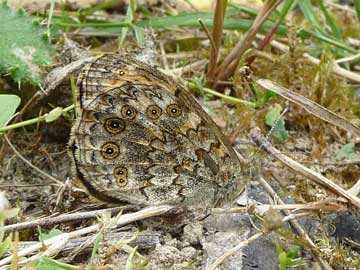
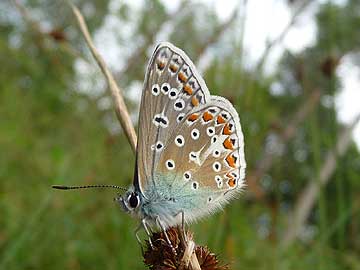
Despite the rather disappointingly overcast conditions I recorded plenty of butterflies flying in Rowland Wood on my transect this afternoon, the undoubted highlight of which was a Wall, very encouraging to see this species so far from the coast and away from The Downs. I also have Purple Hairstreaks to thank for one of my other highlights of the day, while peering into the canopy of an oak (and failing to spot any) I watched a Red Kite sail lazily overhead - it pays to look up!
Species recorded:
Small White - 2,
Green-veined White - 2,
Common Blue - 2,
Red Admiral - 1,
Peacock - 2,
Silver-washed Fritillary - 6,
Speckled Wood - 11,
Wall - 1,
Gatekeeper - 82,
Meadow Brown - 16,
Small Heath - 1,
Ringlet - 33,
(photos above) (Bob Foreman)
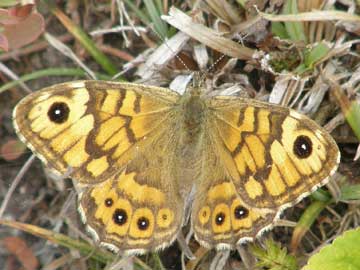
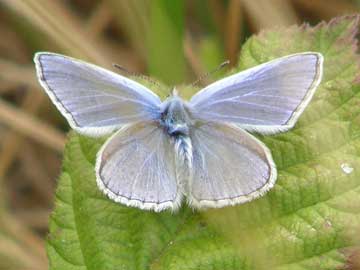
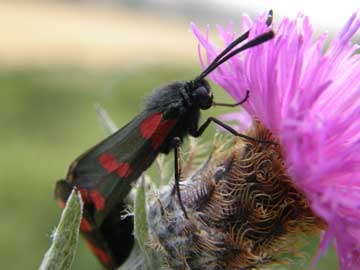

This evening after work I had a relaxing stroll around Mill Hill, Shoreham. As it was obviously butterfly bedtime I had to keep my eyes peeled in amongst the grasses. I didn't see many, but as it was late, they were easy to photograph. I saw Common Blue, Chalkhill Blue, Wall (Brown), Gatekeeper, Meadow Brown and Small Heath. I also found mating Six-Spot Burnet moths and two Cinnabar caterpillars (photos above). (Nick Linazasoro)
Details of the transect walked today, 30th July, at Bedelands Farm, Burgess Hill, butterflies recorded are;
Small Skipper, (4)
Large White, (9)
Small White, (5)
Green Veined White, (1)
Purple Hairstreak, (2)
Small Copper, (23)
Common Blue, (244)
Holly Blue, (4)
Red Admiral, (1)
Speckled Wood, (8)
Gatekeeper, (633)
Meadow Brown, (247)
Ringlet, (9)
Total 1190 butterflies, 13 species. (David Pyle)
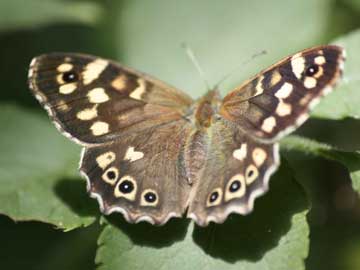
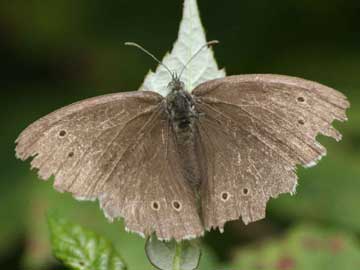
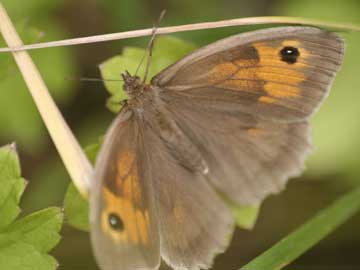
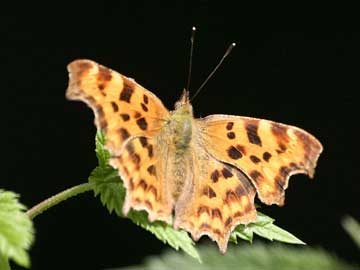
Sighted (above) at Ardingly Reservoir morning of 30 July 2010 (Peter Cockerill)
On the lower slopes of Mill Hill on a day when the sun failed to shine through the clouds, it was a struggle to reach a hundred Chalkhill Blues to the acre on the lower slopes of Mill Hill, Shoreham. Two females were spotted. (Andy Horton)
Tetrad TQ7022 Near Robertsbridge TQ700230 1 Large White, 24 Meadow Brown, 22 Gatekeeper, 3 Ringlet, 1 Small Copper, 2 Speckled Wood, 5 Common Blue. TQ710230 2 Small White, 2 Green Veined White, 9 Meadow Brown, 10 Gatekeeper, 3 Speckled Wood, 4 Common Blue. Tetrad TQ7024 Near Robertsbridge TQ7002400 4 Large White, 2 Small White, 9 Meadow Brown, 20 Gatekeeper, 2 Speckled Wood. TQ710240 2 Large White, 12 Meadow Brown, 2 Gatekeeper, 1 Red Admiral, 2 Common Blue. TQ710250 2 Gatekeeper. Tetrad TQ7224 Near Robertsbridge TQ720240 2 Gatekeeper, 2 Meadow Brown, 1 Speckled Wood, 1 Common Blue. (Roy Wells)
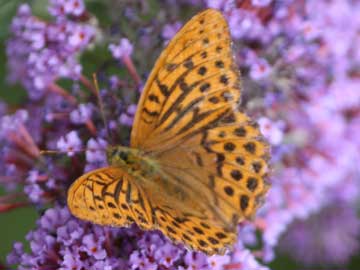

News for Thursday 29 July 2010: Yesterday morning at Climping/Atherington, I was watching a few common butterflies on a buddlea bush, when I noticed what I thought was a Silver-washed Fritillary there. This was close to the shingle beach, which I thought an unusual location. Fortunately I had my camera with me and took a couple of snaps (above) - which I showed to friends who say they feel it is indeed a Silver-washed. (Owen Mitchell)
News for Tuesday 27 July 2010: Tetrad TV6096 Downland at Holywell, Eastbourne TV600970 1 Chalkhill Blue
Recent news: On Friday the 23rd of july at 14.40pm my wife and I watched as a female Purple Emperor flew slowly around our back garden. It actually settled on the table we were sitting at (I was eating plums). We are located in Poppy Close in Southwater, fairly urban and a good distance from Southwater Woods. I have never seen anything like this before and was speechless, my best sighting in over 40 years.
Of further note a reared female Emperor Moth attracted 6 males to our garden this year. I have tried this for several years and this was the first time it proved successful. (John Knott)
Neil Hulme has confirmed to me that my "naked moth" is indeed a Convolvulus Hawkmoth. Anyone who has has had the forethought to plant Nictotiana / Flowering tobacco plant, keep your eyes open as the migrants are upon us. (Richard Roebuck)
News for the whole of last week: Just returned home from a week-long holiday in North-West Sussex. Spent the week exploring this part of the county - visiting some areas that were new to us and recording butterflies for the Atlas. Purple Hairstreaks were everywhere of course - as were Silver-Washed Fritillary. One small woodland glade near Fernhurst held 20! Tuesday was a big day for me! As many of you know I have never seen a Purple Emperor before. Of course I've had many opportunities to join Neil on one of his walks but I always wanted to find my own and, as I've told many people, I hoped that one day one would land right in front of me. On Tuesday 27th July 2010 that's exactly what happened. Not just one - but two Purple Emperors came tumbling out of the sky right front of me! The unfortunate thing was, however, that I was travelling at 45mph at the time, driving down a road adjacent to Stansted Forest. I glimpsed two large butterflies as they fell fighting from above. Before I could slam on the brakes they were sucked under the car! As I gazed into the rear view mirror I saw one fly off apparently unharmed. The other was flat on the road but righted itself - and I swear I saw it dust itself off - and that's when I saw that unmistakable profile. It too took flight and was gone. Unbelievable! We put the hazard lights on and leapt from the car and stared up into the canopy at the amazing sight above. We were directly below a Master Tree with three Emperors soaring, fighting and attacking the odd passing bird. Next day Neil joined us and a fourth, a female, was located. Neil explained that the previous day I had almost killed a male and female - female Emperors have been known to tumble from the sky to evade the advances of a male. It could have ended tragically for all three of us - but luckily we all lived to tell the tale - and mine is of my first Purple Emperor; seen in my rear view mirror. Today was my birthday and my birthday wish was to find a Wood White in a new tetrad. We explored an area around Shillinglee and spent an enjoyable few hours recording. After splitting up to survey a field I froze in my tracks when I heard Clare yell "Wood White" at the top of her voice. Despite my advancing years it's good to know I can still still cross a 800m field in 8.5 seconds when there's a rare butterfly at stake. Clare had found me a great birthday present - a Wood White - just what I've always wanted! And not just one...4!! A great record at a new site for a species which seems to be having a very good year. I'm loving this atlas recording! (Michael Blencowe & Clare Jeffers)
Richard Roebuck's Convolvulus HM: The dishevelled and scale-free appearance, and the circumstances of the find indicate this moth has almost certainly been mauled by the local moggy. Note particularly the 'bald head' - actually the thorax of course minus scales! I have seen the same thing myself on more than one occasion - most recently with a pine hawkmoth in my own garden in Westfield when found close to the moth trap, not in it, on the morning of 19 August 2007.
Cats can quickly bat a large hawkmoth out of the air while it's hovering at flowers like tobacco, or sometimes when attracted to a porch light left on all night. And being so large a hawkmoth is easily held down by a cat compared with smaller, more agile moths. The victim is then found in a bad way the next day on or near the ground where the cat finally lost interest - Richard's example can count itself lucky to still have the power of flight! (Ralph Hobbs)
Thursday 29 July 2010

I have two colleagues, Dorothy and Alan Bonner, who live in Southbourne near to Emsworth. They have just asked me to identify a butterfly which they took a photo of whilst it was settled on their wheelie bin, in their garden. (above)
I am convinced it's a Purple Emperor. Do you agree? Even though the habitat is all wrong and there are no appreciable woods anywhere near. I have read that they are strong wanderers. I cannot find any records of Purple Emperors in this part of the world, where might it have travelled from do you think? (Tony Wootton, Emsworth)
Response from Neil Hulme: This is a female Purple Emperor, recognisable by the slightly more-rounded wingtips, and the width of the white band on the hindwing. Males don't always show the purple sheen (which depends on the angle from which the insect is viewed), so the lack of purple is not itself diagnostic from a single image. However, the base colour is a slightly different brown - and this is typically 'female'. Females will wander long distances through the landscape, searching for sallows on which to lay their eggs. While driving along the A27 just to the North, I've noticed an abundance of sallow in the local landscape. Only yesterday I was watching male Purple Emperors disputing their territory 2 miles to the NW, but the butterflies might also be present in the much smaller copses to the North of Southbourne.
Mary and I had a very pleasant walk from Storrington village to Kithurst Hill, via Chantry Hill. We recorded 23 species of Butterfly, as follows: Small Skipper, Silver-spotted Skipper, Brimstone, Large White, Small White, Green-veined White, Small Copper, Small Blue, Brown Argus, Common Blue, Chalkhill Blue, Holly Blue, Red Admiral, Peacock, Comma, Silver-washed Fritillary, Speckled Wood, Wall, Marbled White, Gatekeeper, Meadow Brown, Ringlet and Small Heath.
Highlights included, Valezina (female variant) of Silver-washed Fritillary, 3 male Silver-spotted Skipper and a male Wall Brown nectaring on Knapweed. The latter two species were in superb condition, suggesting that they were newly emerged.
We missed out on Large Skipper (in my garden on the 25th), and interestingly the 23rd species for the day was Speckled Wood which is very common in this area but clearly 'between broods'. (Martin and Mary Kalaher)
Seen today my first Painted Lady of the year, nectaring on fleabane. My large and very untidy garden in South Mundham has hosted most of the normal coastal strip species this year. Of note are very good numbers of Common Blue, Commas, and quite a few Brown Argus. Purple Hairstreaks are present in the oaks, but hard to see with the strong breezes of recent days. (Phil Down)
On a short visit today to Footlands Wood near Robertsbridge in East Sussex I was very surprised to see a single Chalkhill Blue (male) which I believe is the first record of the species in this area. Other species seen were the usual: White Admiral, Silver-washed Fritillary, Comma, Common Blue, Small Skipper, Meadow Brown, Gatekeeper, Ringlet, Speckled Wood, Large White and Small White. (Rob Bogue)
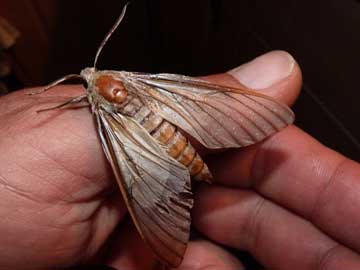
Switched on the moth trap late yesterday evening and within a few minutes heard this flapping noise by a bush on the lawn. On investigation found this huge moth with very little attire to speak of, initially I thought it was an elderly Privet Hawk. Having studied the pic with Waring and Townsend the proportion of the antennae and the remaining grey hairs around the head and legs leads me to think its a male Convolvulus Hawkmoth (above). I would Welcome any other more informed opinion. What a journey this moth must have had? However it's not finished its journey yet as I quickly released it on its way. (Richard Roebuck)



A walk up Windover Hill showed Chalkhill Blues everywhere, Marble Whites, Small Skippers, dozens of Gatekeepers on the brambles and prunus bushes, Meadow Browns, Large Whites, Small Coppers, Small Blues, Small Heaths and the final prize, a Grayling. There were many yellow moths which I have not identified (see yesterday's note: "Identifications for Richard Roebuck" from Neil Hulme - ed.), and Six Spot Burnets plus a pair of kestrels (photos above). (Colin Knight)
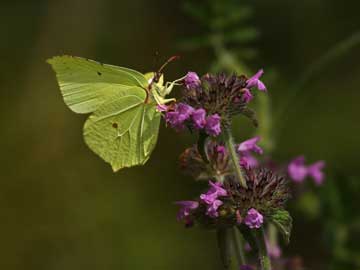
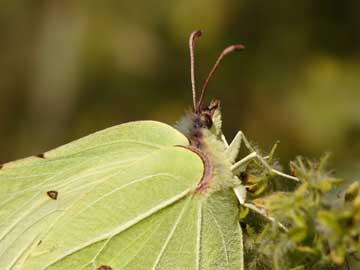
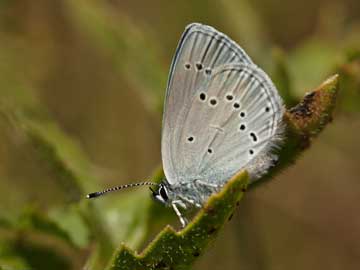
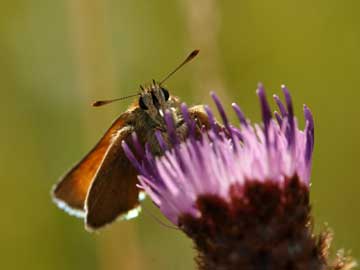
News for Wednesday 28 July 2010: I spent a few hours at Cissbury on the 28th and had a lovely time wandering the slopes looking for butterflies. Species seen included: Brimstone, Brown Argus, Chalkhill Blue, Comma, Common Blue, Dark Green Fritillary, Gatekeeper, Marbled White, Meadow Brown, Painted Lady, Peacock, Red Admiral, Ringlet, Small Blue, Small Copper, Small Heath, Small Skipper, Small White, Speckled Wood and Wall Brown. As part of my continuing mission to find Essex Skippers I made an effort to look underneath all Small Skippers encountered on the walk (trying to find inky antennae undersides) but did not find any. This behaviour of mine, I might add, is quite a challenge given that I've lost my angle finder adapter for my camera and must look distinctly odd to anyone happening to be looking in my direction at the time. While I may not yet be finding Essex Skippers I suspect I will be building up quite a collection of Small Skipper shots!
PS. To Bill who I met while he was walking his transect - Thank you for your advice on the best spots to visit and I did see Painted Lady after all :) I don't know if you can include it in your count for the day - it was just one individual and it was nectaring in a little group of flowers close to the gate from the car park: approximately TQ 139 084. (photos above)(Sherie New)
Clockwise from top left (below): Cynaeda dentalis, Dark Tussock, Shore Wainscot, Pale Grass Eggar, Reed Dagger and Pigmy Footman f. pallifrons, (Dave and Pen Green)
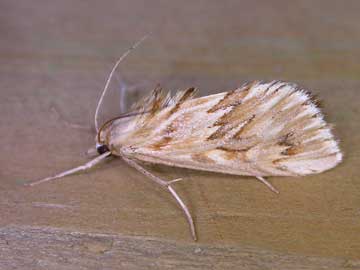
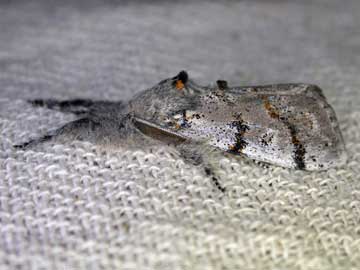

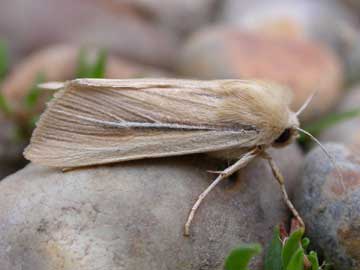
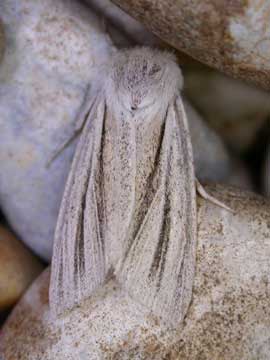
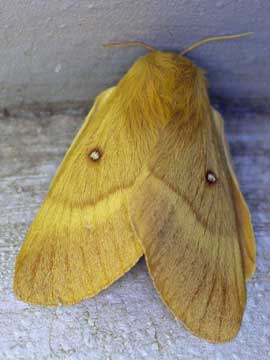
Recent news: Last weekend we were lucky enough to gain permission to trap on the vegetated shingle at the Lydd Firing Ranges, east of Rye Harbour. We ran two MV traps just inside the Sussex border in the area of the Midrips and The Wicks. The temperature was mild with a strong easterly breeze, so migrants were in very short supply, but as the evening went on some of the hoped for species appeared. These included a number of specialities of the Dungeness/Midrips area including a number of RDB and Nationally Scarce moths. Of the 40 or so species caught, RDB highlights included five specimens of the beautiful micro Cynaeda dentalis, 54 Pigmy Footman f. pygmaeola, three f. pallifrons and four Pale Grass Eggar. We also caught ten Grass Eggar, a female Oak Eggar, six Reed Dagger and three Dark Tussock, although the Tussocks didn't put in an appearance until about 2:30am. It was a great nights mothing, and on the way back we popped into Rye Harbour to see some Shore Wainscot which had been caught that morning. (Dave and Pen Green)
Wednesday 28 July 2010
Brown Hairstreak at Ifield Common 11am today. Park in Rusper Road car park, cross football pitches to gap in hedge and view ash tree 50 yds ahead. Be aware of numerous Purple Hairstreak in same tree. (Jim Joyce)
I saw a Silver-washed Fritillary in the woods near West Marden today. (Adam Howard)
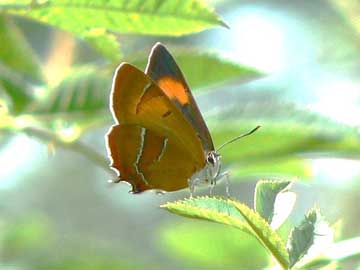
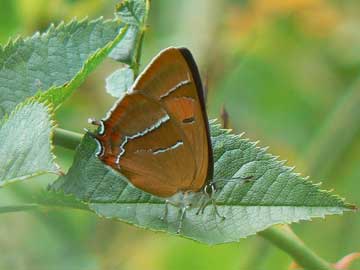
Having seen note from Andrew Guest of Brown Hairstreaks at Pulborough Brooks we went to Povey Cross and were pleased to find a female butterfly. (above) Difficult to locate with large numbers of Gatekeepers and the blackberries not yet ripe. (David & Molly Dancy)

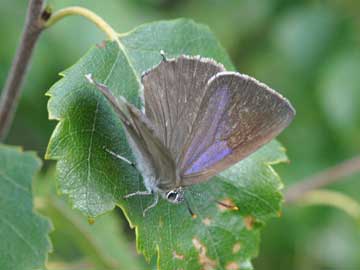
I feel I have lived in Abbotts Wood this week with 4 visits, 3 mornings and 1 evening, 2 with Nigel Kemp who kindly tipped me off about the site. In one of the cleared area there are several oak saplings which are around head height and occasionally a Purple Hairstreak flies across the clearing and settles on one of these short oaks. Unfortunately it is as I say only occasionally so a lot of perseverance is called for. It is also very frustrating as most of the time there are plenty of butterflies flying around the tree tops well out of range. On Monday morning I was lucky enough to get 3 flying and settling at ground level. This was followed by 2 blank photo visits, although Nigel got some good shots Tuesday morning, and there was plenty of other butterflies showing well with some excellent Small Coppers and hundreds of Gatekeepers, several Common Blue and a Holly Blue. Anyway, today my patience paid off with a very nice adult spotted on a very low oak which allowed several shots before it flew off and settled again with this time its wings partially open (above). I then stopped off at High and Over where at least 5 Wall Brown males were seen. Whilst I was there Matt rang me to say a Purple Hairstreak had just settled in our garden!!!! (Bob Eade)
Today I wanted to count the number of butterflies that entered my garden, I saw 22 Gatekeepers, 12 Speckled Woods, some landing on a rotten banana I put out in the sun. Also a few female Holly Blues landing on the Hebe bush. 6 Commas which didn't settle and flew around the garden for a bit then flew off. 21 Large Whites mainly passing by. 52 Meadow Brown mainly feeding on my Hebe bush. 48 Small Whites some laying eggs on the nasturtiums, sometimes coming into the garden in large groups. Also 1 Common Blue which didn't stay for long and 1 Peacock that made an appearance as the sun was going down. Also later finding a pair of mating Six Spot Burnets on the lavender in the garden. I managed to count a total of 167 butterflies including the 2 Burnet moths. (Jamie Burston)
With three days before the peak emergence of Chalkhill Blue Butterflies on Mill Hill (north of Shoreham, Sussex) would be expected, the numbers are extremely poor with just 49 males recorded on the lower slopes transect on a cloudy day. The first second brood male Adonis Blue was noted on the lower slopes, with five Wall Browns amongst 17 species of butterfly seen on Mill Hill and its approaches. Male Common Blue Butterflies were almost as frequent as the Chalkhill Blues on the lower slopes of Mill Hill, and on the middle and upper slopes their numbers exceeded 200. Females of these three blue species were not noted, but the cloudy and breezy conditions were well below optimum. Ten Small Blue Butterflies still fluttered around on the southern bank of the Buckingham Cutting. (Andy Horton)
Lancing Rings today, long sunny periods, bit breezy, 19 species seen (3 new ones to add to the 22 seen last week):
Gateckeeper c 80
Meadow Brown c 35
Common Blue c 25
Large White c 20
Holly Blue c 15
Small White c 10
Comma 6
Wall Brown 6
Red Admiral 5
Speckled Wood 5
Small Skipper 4
Peacock 4
Small Copper 4
Brimstone 1 M 3 F
Ringlet 2
Dark Green Fritillary 1 (a different specimen to last week with a chunk missing from a rear wing)
and the new species:
Chalkhill Blue 2
Brown Argus 2
Small Blue 2
The most interesting insect I saw was crawling on a buddliea . It looked like a giant wasp ( well over twice the size ) broad yellow and black stripes but no visible sting. I have no idea what it was. Is there a moth that imitates a wasp? It was not feeding whist hovering. Any ideas welcome. (Mark Senior)
I contacted the Natural History Museum about the Silver-washed Fritillary which is a bilateral gynandromorph and was photographed by myself and Susie Milbank at Southwater Woods. I received the following reply: 'I passed your information on to our Lepidoptera department and they informed me that out of the 1,857 British Silver-washed fritillaries we have in the collection there are 12 bilateral gynandromorphs, making the specimen you photographed very rare indeed.' (Colin Knight)
News for Tuesday 27 July 2010: A look at Red House Common (Chailey) failed to turn up any Silver-studded Blues (following up on a possible sighting), but at least a solitary Purple Hairstreak at TQ390217 can be added to our Atlas database. I also failed to locate any Grayling, where a wandering female was observed at the Ouse Estuary Project (Newhaven) last year. However, my spirits were lifted when I heard some exciting butterfly news from Clare and Michael, currently on a surveying tour of the West Sussex/Hampshire borderlands (where Grayling rustling has been going on for some years). I'll let them break their news! A quick stop at Mill Hill revealed the first male Adonis Blue of the second brood (expect an awesome late summer Adonis 'spectacular' here - starting at the weekend) and two summer brood Wall. I'm afraid the Chalkhill Blue continues to struggle on this site. (Neil Hulme)
Identifications for Richard Roebuck: The prolific yellow moth at Windover is the very localised and scarce Mecyna flavalis, and the 'fluffy job' is a Dusky Sallow. (Neil Hulme)
Tuesday 27 July 2010
2-3 recently emerged Small Blues on our front lawn which is given over to wildflowers and is currently dominated by Kidney Vetch, so a good result. Interestingly did not notice this species in the main first brood flight period and never previously. Also present on the 'lawn' numerous Meadow Brown, Gatekeeper, Large White and a few Common Blue. Have recently also had Marbled White and Essex Skipper. Just goes to show what can be achieved from a very small area of wild lawn which in my case is 6m x 4m. ( Philip Thompson)
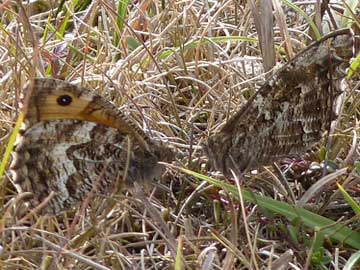
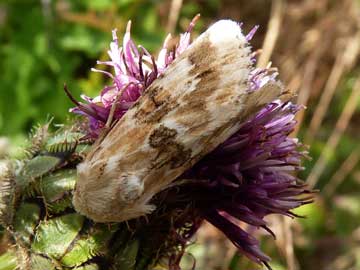
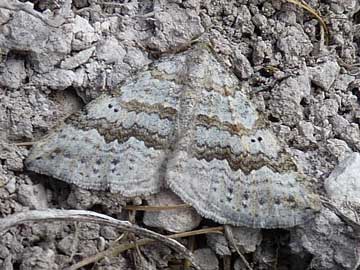
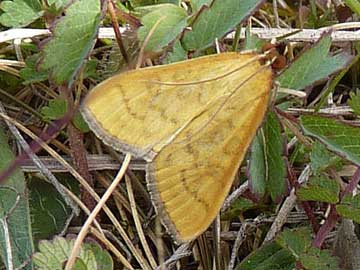
Spent a couple of Hrs at Wilmington and Windover Hill the first time I have been here and what a beautiful place. Started off walking up from car park at Wilmington, saw, Small Blue, Common Blue, Speckled Wood, Meadow Browns, Gatekeepers, Small Skipper, Chalkhill Blues (loads) including mating pairs, Marbled Whites, Small Heath, Small Tortoiseshell caterpillar on path, Painted Lady, Red Admiral, Silver Y, Carried on up the Hill to Windover Hill. Quite soon found several Graylings (8+) my first for Sussex. Very distinctive flight pattern a few inches above the ground, amazing camouflage when at rest. Met fellow enthusiasts (I am absolutely hopeless at re remembering names apologies) however an enjoyable time looking at a courting pair of Graylings (male on the left) (above) followed buy agreed sighting of 5 Spot Burnet amongst the many 6 Spot Burnets. In addition Silver-spotted Skippers, reported Wall by my expert colleague, Also Chalk Carpet, and a distinctive small yellow moth which was numerous, and another distinctive noctuid type moth I found later. Any ideas on moth i.d welcome please. TQ5403, a fab place to visit, too little time. (Richard Roebuck
1 Hummingbird Hawk moth nectaring on red valerian, County Hall, Lewes, late afternoon today. (Jeremy Patterson)
News for Sunday 25 July: We walked through Friston Forest on Sunday and saw:
8-10 Grizzled Skippers
2 or 3 Small Whites
2 Red Admirals
2 Gatekeepers
all at the top edge of the Forest just above Charlton Bottom. (Pat Taylor)
Monday 26 July 2010
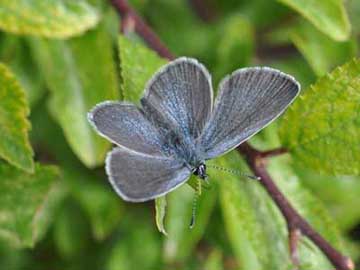
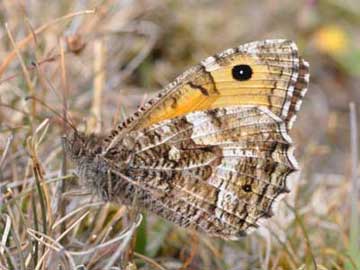
Quite a day of butterfly hunting today starting with Abbotts Wood with Purple Hairstreaks being the main target. 3 were seen at ground level where I managed to get my first photos of these delightful creatures since the 1980s. I then went onto Wilmington Hill where many Small Blue were seen along with large quantities of Chalkhill Blue and Gatekeepers. In Deep Dene there were good numbers of Grayling. Tried for ages to get one with its forewing showing and eventually managed to get a half decent shot of one. In the afternoon went for a walk with the other half, (the better half) to Tide Mills where a superb male Wall Brown was seen (photos above). (Bob Eade)
A rather bald-headed Hummingbird Hawkmoth was in my garden yesterday (25th), but not doing normal Hummingbird things. Instead, it was buzzing slowly through the flowerbed in awkward jerks, never still but not the hover-dash-hover-dash you expect. Then jackpot! as it (ie she) found the patch of Lady's Bedstraw I have had growing for several years expressly for this purpose, and began laying eggs, one at a time. This evening she's back again doing the same. Bring on the chunky green caterpillars! (Adrian Thomas)
For the past 10 years I have had a colony of Burnet moths at the end of my garden. This year the caterpillas did not appear as usual but 2 weeks ago I noticed some crysallis on long grass. These are half the normal size and so far only 3 moths have been seen on the wing, looking smaller also. The only thing that has been different this year from other years is the late cold spring/summer nights. I live surrounded by organic farmland and garden organically. (Sunniva Harte, Hankham, Pevensey. East Sussex)
Seen this evening, Purple Hairstreaks in the canopy of oaks at the bottom of my garden - though not on my land. I shall now look for them in Oak in my front garden! Thanks to Michael B for the literal "heads up"! (Stuart Cooper)
5-6 Yellow-legged Clearwings attracted to pheromone lure at Park Corner Heath on Monday under overcast skies. (Darryl Perry)
News for Sunday 25 July: We tramped over Chapel Common, we tramped across Weavers Down, the clouds lifted and the hot sun beat down but sadly never a Grayling was found. However many other species were seen and, as always, a day with Michael Blencowe and Clare Jeffers is always enjoyable and most amusing and with Bruce Middleton's knowledge of the area we learnt a great deal. Don't be disheartened, Michael! Remember: (as was quoted by a wise participant), "Absence of evidence is not evidence of absence." (Margaret Hibbard)
Sunday 25 July 2010
Big thanks to Stuart Cooper for filling in for me while I was absent over the weekend and apologies for the e-mail hiccup too, I think everything has cleared through now but if your sighting report or photo(s) have not appeared please resend and I'll get them up as soon as is humanly possible - ed.
I spotted a White-letter Hairstreak nectaring on buddleia under a mature elm tree at 12.30 today in Second Avenue, Hove. (Alan Barrett)
Saw my first White-letter Hairstreak for the Warnham area on Friday, but in rather unusual circumstances.
I have been monitoring a pair of Spotted Flycatcher that are nesting nearby in a barn, currently on their second brood, and went up to ring the three chicks and the first thing I was greeted by was a half dead Hairstreak on the edge of the nest presumably rejected by the chicks as a meal (perhaps the wings were too much for them).
I am not sure how to record this as the Hairstreak obviously didn't make it to the barn of its own accord and could have come from anywhere in a relatively large area - would it go down as 'bird-assisted'? (Sam Bayley)
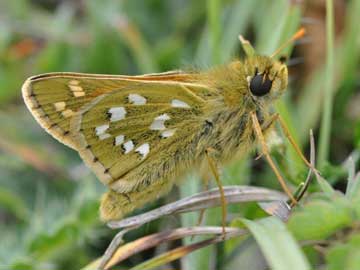
A brief visit to High and Over and Frog Firle produced 5 Wall Brown at High and Over along with a Holly Blue and some smart Commas. On Frog Firle Silver Spotted Skippers (above) are now emerging in good quantities. 2 Small Blue were also notable. (Bob Eade)
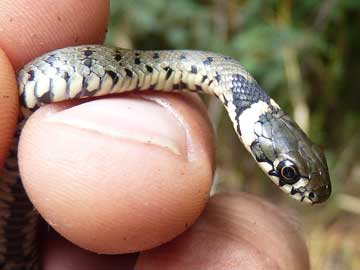
Went to Camber sands on Saturday to have a look around a Dune habitat for butterflies. At the edge of maram grass where ragwort, Rosebay willow herb and Vipers Bugloss were in flower saw Common Blue, Brown Argus, Small Skippers (possibly Essex) Meadow Browns, Gatekeeper, Red Admiral, Peacocks, lots on Brambles, Large and Small Whites, Silver Y, Cinnabar caterpillars, a Migrant Hawker, lots of common hawkers and a Large Marsh Horse Fly Tabanus autumnalis. Tetrad TQ9518 . On Saturday afternoon saw 4 Purple Emperors in local woods at Spithandle, and on Sunday, Silver-washed Fritillary laying an egg on bark near base of an Oak tree and female Purple Emperor egg laying on sallow. Also Speckled Woods, Meadow Browns, Purple hairstreaks, White Admirals, Holly Blues, Commas, Red admiral, Large White, Green-veined White, Peacocks. Lastly came across a young Grass snake who agreed to pose for photos (above). (Richard Roebuck)
Pulborough Brooks: Brown Hairstreaks ( 2 female, 1 male) visible in master Ash on nature trail near the Hangar crossroads this morning. Also along the trail, many Meadow Browns, Gatekeepers, Small and Green-veined Whites, 3 Speckled Woods, 1 Silver-washed Fritillary, 5 Ringlets, 2 Red Admirals, 3 Small Coppers, 3 Commas, 8 Common Blues, 1 Peacock and a few Large Whites. (Andrew Guest.)
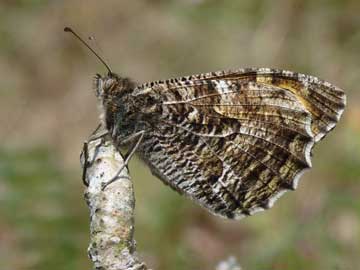
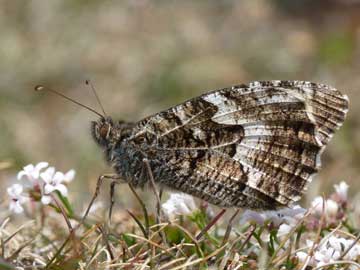
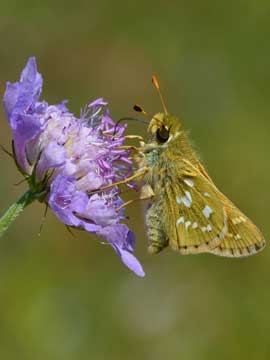
News for Saturday 24 July 2010: A visit to Windover Hill and the adjacent valley produced my first Grayling of the year - about a dozen in all, including a single female (top, left). Other species included Small Blue, Chalkhill Blue, Common Blue, Brown Argus, Small Copper, Dark Green Fritillary, Painted Lady, Peacock, Red Admiral, Comma, Marbled White, Meadow Brown, Gatekeeper, Small Heath, Small Skipper, Large Skipper, Large White and Small White. Moths included a Hummingbird Hawkmoth and large numbers of Silver-Y. Moving on to Cradle Valley ('High and Over') I saw about 20 Silver-spotted Skippers (above), with some females already on the wing and being pursued by amorous males. One unlucky chap got 'nailed' by a Hornet Robberfly. A fuller story appears at http://www.ukbutterflies.co.uk/phpBB/viewtopic.php?f=29&t=4065&start=100. (Neil Hulme)
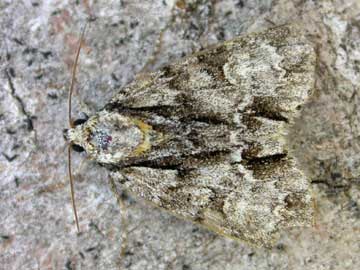
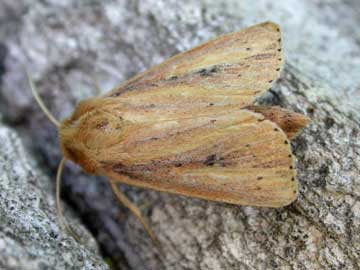
More news for Saturday 24 July: Like buses, you wait for one for ages, and then another comes along just after! Since 1933 when Marsh Dagger (above left) became extinct as a breeding species in the UK, up until this week the only UK record of this moth was of a single migrant at Rye in 1996. This changed when earlier this week one was recorded at Pagham Harbour, and on Thursday morning another was discovered in the regularly run moth trap at the Sussex Wildlife Trusts' HQ, Woods Mill. Another moth of note caught that night at Woods Mill was a Webb's Wainscot (above right). More can be seen at Graeme's Blog at http://analternativenaturalhistoryofsussex.blogspot.com/. (Penny Green and Graeme Lyons)
There have been 2 reports of Chalkhill Blue in Rother in the past week, one by Katie Walker at Brightling (Monday 19th) and one by Gordon Jarvis at Beckley Woods (Saturday 24th). I wonder if there will be some more sightings of these lovely butterflies away from the Downs this year? (Steve Wheatley)
3 Hummingbird Hawkmoths and a fresh Painted Lady at Hope Gap in the morning. (Matt Eade)
Today's BC walk was planned as a 'Butterfly Atlas event' and targetted some tetrads in Northwest Sussex from which we have no records at all - who knows what we would find. A team of intrepid members met at South Harting and climbed up onto the South Downs where we met with Tom and Barbara Ottley who had already discovered a fantastic 'hidden' piece of Chalk Downland. Large White, Brimstone, Gatekeeper, Meadow Brown, Red Admiral, Speckled Wood, Small White, Ringlet, Green-veined White, Silver-washed Fritillary, Peacock, Marbled White, Common Blue, Brown Argus, Small Skipper, Small Copper, Large Skipper, Holly Blue were soon added to the list before we headed west into West Harting Down. Here we were able to add Essex Skipper to the list before we sat down for lunch dangerously close to the Hampshire border and gazed out across to the Isle of Wight. Eagle-eyed Adrian Thomas spotted a rarity - an oak tree - the only one we saw all day. And sat on top of that oak tree? A Purple Hairstreak! Despite there apparently being no other oaks for miles this hairstreak proved the point that you find the oak - you find the hairstreak. Even more amazing was that Tom had found a Wych Elm - another rarity in this area. And on top of that Wych Elm? 3 White-letter Hairstreaks! We have a record of this species from Harting in 1978 but in recent years we've had no WLH records away from the coast. Once again you find the elm - you find the hairstreak. A great day out in a lovely 'un-discovered' part of the county - thanks to all who came along - especially Mr Thomas & Mr Ottley for their Hairstreak spotting-skills. (Michael Blencowe)
Many thanks to Michael and Clare for leading a hugely enjoyable field meeting starting from South Harting. The main objective was to survey just one tetrad for the Sussex Butterfly Atlas. With over 20 species seen it was successful in that respect alone. But what a square! Meadows full of flowers, woods with wide rides filled with Hemp Agrimony and consequently high counts of many of the commoner species and some of the less common ones too. Even the picnic spot had a view reaching to the Isle of Wight. We found possibly the only two oak trees in the tetrad and one of them even had its own Purple Hairstreak, well spotted by Adrian Thomas. This was a well planned field trip indeed. (Tom Ottley)



On Saturday I joined a most enjoyable walk led by Michael Blencowe and Clare Jeffers at South Harting . Tom Ottley was able to find some Essex Skippers for us among the Small Skippers and also a tall Wych Elm with resident White-letter Hairstreaks. We spent 30 minutes watching the tree top waiting for the next sun burst between clouds. Every time the sun shone through the little fellas would fly up and a spiralling pair would argue about territory. We walked through about three tetrads, calling out the names of finds. A pair of Silver-washed Fritillaries spiralled away in a courtship dance. While they were resting I took a photo of the male and only noticed later that a either female Common Blue or Brown Argus (some were seen) had appeared in flight beside it. A hover fly also pestered a resting Common Blue. A couple of dozen species were recorded during the day. (photos above) (Colin Knight)
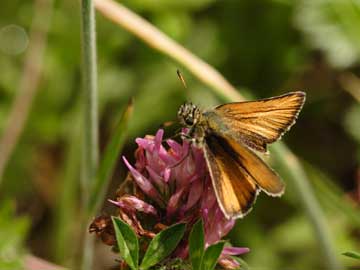
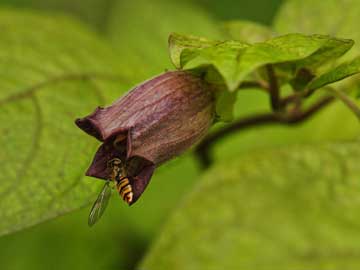
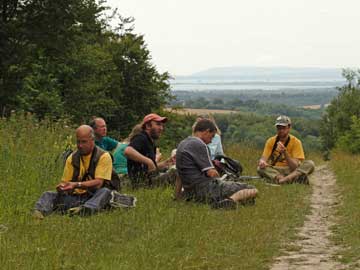
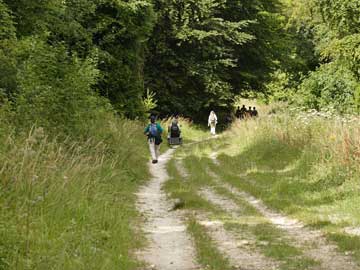
My thanks to Michael and Clare for leading this lovely walk. It really does add a little something to your walk when you are 'discovering' new butterflies for the Atlas with every step you take. I think it could be addictive. And we saw lots :). There were Whites of all kinds, brilliant Red Admirals in pristine condition, Peacocks, Commas, Silver-washed Fritillaries, Small Copper, Skippers and more. The long ride along which we walked at the top of the Down had abundant flowers and when the sun came out there were butterflies all around us. At some spots you just had to stop for a while to take it all in, it was absolutely beautiful. Thanks to the observations of Tom and Adrian we were able to locate both Oak and Elm (both of which seemed very scarce in the area) and this enabled us to find both Purple Hairstreaks and White Letter Hairstreaks. My personal favourite, though, was the Essex Skipper. I was able to see one close up in a specimen jar (thanks Michael) and, with Tom Ottley's help (thanks Tom) I was able to photograph one too. We also saw Deadly Nightshade (photo attached), Blood-vein moth, Dark Mullein, Nettle-leaved Bellflower, Round-headed Rampion and more. I believe our butterfly count was over 20 species which has got to be good going for one walk. It's a lovely spot and well worth the effort to get up the hill for anyone interested in going. One of the group photos attached shows the group sitting at lunch with the Isle of Wight in the distant background (photos above). (Sherie New)
A walk up Windover Hill today and a look around Litlington produced a total of 21 species the highlights of which were:
Grayling 4 (thanks Neil)
Marbled White 8+
Small White 20+
Large White 5 (1 Litlington)
Green-veined White 2 (1 Litlington)
Common Blue 4
Chalkhill Blue many
Small Blue 35+
Holly Blue (Litlington)
Brown Argus
Purple Hairstreak (on top of Windover hill!)
Comma 5 (1 Litlington)
Red Admiral
Peacock
Painted Lady
Gatekeeper many
Meadow Brown many
Small Copper
Essex Skipper
Dark Green Fritillary 5+
Speckled Wood 2 (Litlington & Wilmington chalk pit)
Also a single Oak Eggar in Litlington & later in Hailsham town centre a total of 6 male Oak Eggars all around the base of a wall at the Co-op car park in an absolute frenzy. I looked for some time but was unable to find a female so do not know what the attraction was! (Chris Ball)
Tetrad TQ5216 Davis's Town, near East Hoathly TQ530170 4 Large White, 11 Meadow Brown, 8 Ringlet, 10 Gatekeeper,1 Comma, 1 Red Admiral, 1 Holly Blue. Tetrad TQ5218 Butlett's Wood, near Blackboys TQ530190 2 Large White, 1 Small White, 1 Green Veined White, 16 Meadow Brown, 3 Ringlet, 7 Gatekeeper, 2 Peacock, 1 Small Copper, 11 Common Blue, 2 Speckled Wood. (Roy Wells)
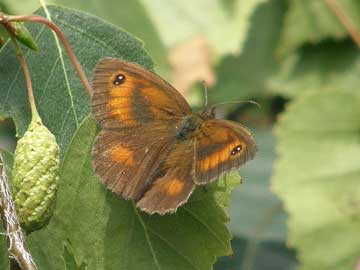
We saw this Gatekeeper (above) in our garden this morning. (Nick Linazasoro)
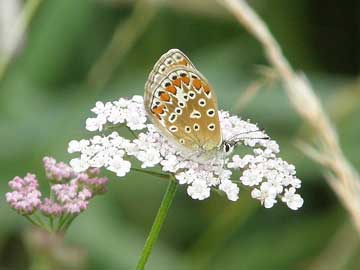
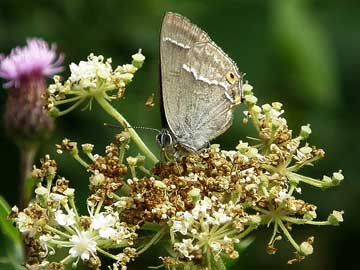
Today we ventured to Woods Mill where we saw our first ever Purple Hairstreak. We also saw Large Skipper, Large White, Small White, Common Blue, Adonis Blue, Red Admiral, Comma, one Silver-Washed Fritillary, Speckled Wood, Gatekeeper and Meadow Brown.
We also did some pond dipping a found a newt tadpole and several dragonfly nymph. We also spotted several damselflies and dragonflies (photos above). (Nick Linazasoro)

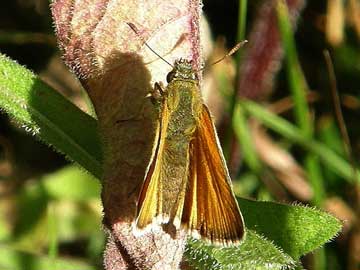
We also ventured to Loder Valley Nature Reserve where we saw one Kingfisher as well as Essex or Large Skipper, Large White, Small White, Common Blue, Gatekeeper, Meadow Brown and we were treated with a few White Admiral and lots of Silver-Washed Fritillary (photos above). (Nick Linazasoro)
Checked the small oak woods just north of my house in Edburton on 24th and found 4 White Admirals, 14 Silver Washed Fritillaries and 10 Purple Hairstreaks + common species. In the garden Dark Green Fritillary and Hummingbird Hawk Moth have been daily for over a week + Brown Argus, Marbled White, Small Skipper and the best of the moths were a European Corn Borer and a Lunar Spotted Pinion + plenty of Silver Ys. (Tony Wilson)
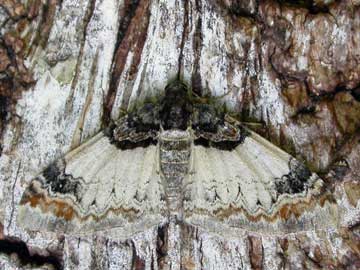
News for Friday 23 July: Friday's moth trap produced a few new moths for the year including Early Thorn, Dot Moth, Lychnis, Marbled Beauty and a first for our garden, Royal Mantle (above). 7 Diamond Backed Moth were suggestive of immigration into Sussex but it was the first trap for ages without any Large elephant Hawkmoth. (Dave and Pen Green)
News for Thursday 22 July: A quick look in Park Wood Maresfield this morning, 3 Silver Washed Fritillaries and a fresh looking White Admiral. This species seems to be doing better than for many years, Mike Cameron reports record numbers in Plashett Wood [no access] They have even found one in Kent!!
Bob Eade's comment on Wall brown at High and Over is spot on, when I used to do the Transect, if there were Walls about, there would always be one by that gate. (Graham Parris, Isfield)
Recent news: For the second weekend in a row (Fri 16th, Sat 24th) July we have captured a Waved Black In our moth trap in Catsfield, according to the moth book it is nationaly scarce B! (Rob Brownnutt and Lyn Kellaway)
More recent news: 24 July 2010: At least two Holly Blues and a few Small Whites, not seen the previous day, were seen around the Buddleia on the Adur Riverbank by the houseboats where the most frequent butterfly were Red Admirals with a few Gatekeepers and Large Whites fluttered around in the humid sunshine. This is a first flower stop for immigrant Red Admirals.
23 July 2010: On a cloudy day, the meadow north of the upper car park on Mill Hill exploded in blue butterflies with ten male Common Blues in a square metre on about fifteen occasions and more blues and other butterflies over the rest of the meadows on Mill Hill giving total numbers seen in excess of 400. All were males and no females were spotted. Many more were hidden on a cool day. The Chalkhill Blues on the lower slopes were not flying unless disturbed so only fifteen were seen on the 1.2 acre transect. Fifteen butterfly species were seen on a cool day.
20 July 2010: My first Hummingbird Hawk-moth, Macroglossum stellatarum, of the year put on an attractive display as it hovered/flitted around a clump of Greater Knapweed in the north-west corner of Frampton's Field, Old Shoreham. On the lower slopes of Mill Hill, the count of male Chalkhill Blues were still a mere seventeen. Although it is over a week to the peak period, it still looks like it will be another poor year for this downland butterfly.
19 July 2010: It was on a small grass verge next to the A27 dual carriageway in north Lancing (opposite of Lancing Manor) that I spotted my first Small Copper Butterfly of the year.
9 July 2010: An unprecedented number of over forty Ringlet Butterflies were seen on the Slonk Hill Cutting meadows in north Shoreham.
8 July 2010: On the Lancing Clump meadows, well over a hundred butterflies fluttered about; I recorded sixteen species on the day including very frequent Marble Whites, Meadow Browns and Small Skippers. (Andy Horton)
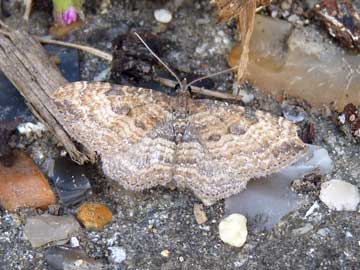
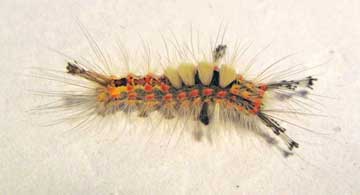
Gem, Hailsham (Chris Ball) and Vapourer caterpillar, (Colin Knight)
Friday 23 July 2010
At some point over the coming week (24th July - 1st August) please consider taking part in our BIG BUTTERFLY COUNT, a nationwide survey aimed at helping us assess the health of our environment. It's really simple and I'm certain you'll find it enjoyable and rewarding. www.bigbutterflycount.org - Steve Wheatley
A drive across West Sussex on friday evening was made more interesting with a few stops here and there to scan the oak tops. Yet again every tree we looked at had a little silver butterfly flying erratically at the top or engaged in frantic, spiral combat with an opponent. Purple Hairstreaks were recorded in 16 tetrad squares; East Wantley, Merrywood Lane, Abingworth, Apsley Farm, Saucelands Farm, Barnhouse Farm, Slaughter Bridge Farm, Copyhold Farm, Melrose Farm, Planted Ash, Shiprods Farm, Toat Copse, Newbridge, Rowner Farm, Shortloes Farm and Colin's Cross. There must be Purple Hairstreaks in every tetrad square in Sussex. If you're out and about in the evening pull over and scan an oak - the hairstreaks were still flying at quarter to nine last night! Send your sightings in to us. (Michael Blencowe)
Tetrad TQ8814 Icklesham TQ880150 1 Large White, 2 Small White, 1 Green Veined White, 4 Gatekeeper, 2 Meadow Brown. TQ890150 1 Large White, 1 Small White, 1 Green Veined White, 3 Red Admiral, 5 Meadow Brown, 10 Peacock, 14 Gatekeeper, 1 Comma, 1 Small Tortoiseshell. Tetrad TQ9224 Iden Lock TQ930240 1 Small White, 3 Green Veined White, 2 Meadow Brown, 3 Red Admiral. (Roy Wells)
Numbers of butterflies recorded at Bedelands Farm during the transect
walked today at 1200, species seen;
Small Skipper, (16)
Large White, (12)
Small White, (5)
Green Veined White, (1)
Purple Hairstreak, (10)
Small Copper, (21)
Common Blue, (81)
Holly Blue, (1)
Red Admiral, (2)
Comma, (2)
Speckled Wood, (1)
Marbled White, (1)
Gatekeeper, (428)
Meadow Brown, (405)
Ringlet, (22)
Total, 1008 butterflies, 15 species. (David Pyle)
A male Gem trapped in my Hailsham moth trap on the night of the 21st July was my first for the garden. (Chris Ball)
Many thanks to Bill Taylor for leading the walk at Cissbury Ring on Thursday afternoon. Fourteen of us shared 19 species (not everybody saw all of them):
Painted Lady
Small Copper
Large White
Small White
Common Blue
Ringlet
Gatekeeper
Brown Argus
Meadow Brown
Brimstone
Red Admiral
Dark Green Fritillary (dozens)
Marbled White
Small Skipper
Small Heath
Chalkhill Blue (c. 50)
Comma
Purple Hairstreak
Large Skipper
Some people had their first ever sightings of several species. Everybody enjoyed it very much. (Peter Atkinson)
Having been confined to home this week due to a knee problem I was
delighted last night to find this unusual moth larva ascending a wardrobe
door. It was about 3 cms long and I identified it as a Vapourer
Moth larva. It escaped from a container while my back
was turned so I expect it has gone off to pupate and I hope to see the
adult sometime. (Colin Knight)
Thursday 22 July 2010
Nice Hummingbird Hawkmoth around mid day in well flowered garden in Cuckfield (David Geoghegan)
We saw one White Admiral in our garden in RH19 today at 5:30pm. Just a hour later a report on it's rarity and a recent sighting in Kent was shown on BBC News. (Mr David Sandall)
News for Wednesday 21 July: 1 Wood White, private land near Ebernoe.
1 Wood White crossing hedge into a field at Butcherlands (SWT) no public access.
1 Wood White disappearing into dense woodland, Ebernoe.
1 Silver-washed Fritillary valezina, Ebernoe. (Margaret Hibbard)
News for Tuesday 20 July: 2 Wood White, a field at Butcherlands near Ebernoe (Sussex Wildlife Trust ownership, no public access). (Margaret Hibbard)
Wednesday 21 July 2010
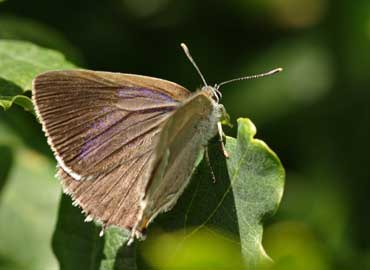
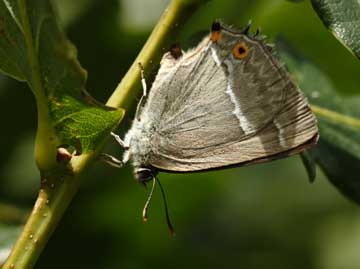
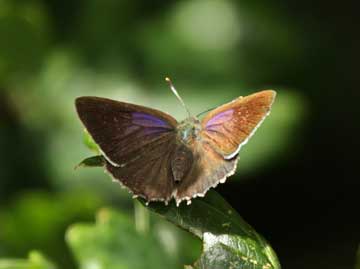
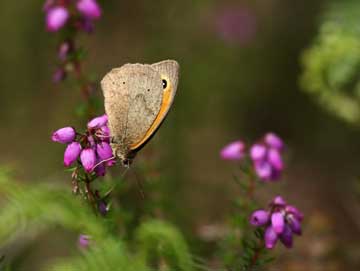
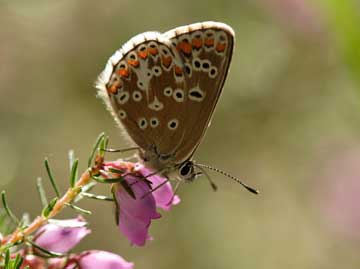
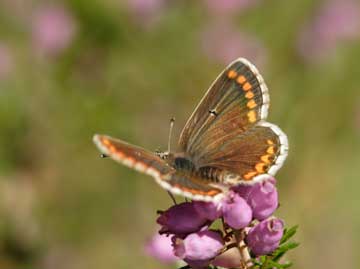
In an effort to conquer unknown territory in NW Sussex I ventured out to Woolbeding Common and Pound Common yesterday. I especially enjoyed the Purple Hairstreaks which seemed to be everywhere. Other species included Meadow Browns, Speckled Wood, Gatekeeper, Large Skipper, Comma, Peacock, Large White, Brown Argus, Common Blue, Small Copper and Red Admiral (photos above). (Sherie New)
2nd brood Wall Brown at High and Over at lunchtime today. This is just 3 days later than the first 2nd brood last year despite the 1st brood being 13 days later this year. It was an immaculate male in exactly the spot that I saw the last 1st brood on the 24th June, by the gate above the white horses' head. (Bob Eade)
A single Purple Emperor spotted circling round a beech tree near the road at Nutley Windmill (Marlpits on the map, TQ 4529 2884). This was seen whilst watching Purple Hairstreaks at 6:30 in the evening. There are suitable breeding sites nearby so the hunt is now on for more. (Tom Ottley)
Fine Morning. Tetrad TQ6216 Rushlake Green TQ620170 Dog Wood 3 Speckled Wood.
Tetrad TQ6428 The Dens, Buttons, near Stonegate TQ640280 49 Gatekeeper, 26 Meadow Brown, 10 Ringlet, 2 Large White, 2 Green Veined White 5 Common Blue, 2 Speckled Wood, 1 Comma, 1 Peacock.
Buttons, near Stonegate TQ640290 6 Ringlet, 25 Meadow Brown, 1 Comma, 1 Large White, 1 Marbled White, 13 Gatekeeper.
Wet afternoon Tetrad TQ6228 Wadhurst Park TQ630290 4 Ringlet, 1 Meadow Brown. (Roy Wells)
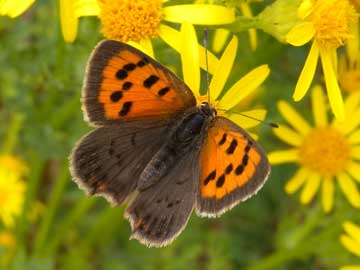
News for Tuesday 20 July: Interesting Small Copper taken at Warnham LNR Yesterday (above). No orange bands at the rear of the hindwings... Not sure what this abberation is called? (Damian Pinguey) - see note below from Neil Hulme

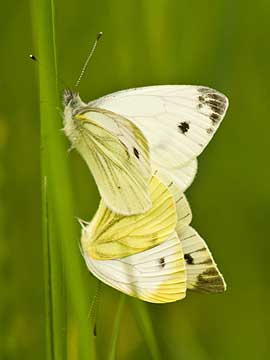
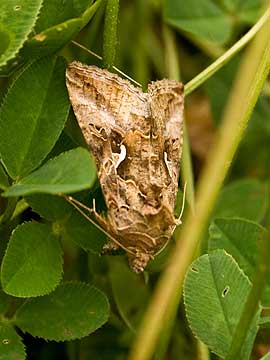
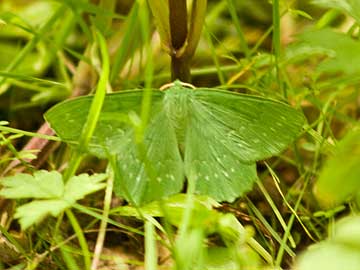
More news for Tuesday 20 July: Surveying a 1km square (TQ5907) just south of Hailsham for the Wider Countryside Butterfly Survey, recorded the following species:
Large Skipper 1
Large White 4
Small White 15
Green Veined White 3
Purple Hairstreak 2
Small Copper 3
Common Blue 1
Red Admiral 5
Peacock 2
Comma 1
Speckled Wood 1
Gatekeeper 22
Meadow Brown 35
6 Spot Burnet 1
Silver Y 2
Unidentified tortricid 1
Later, during a brief wander around Rowland Wood, I photographed a Large Emaerald (photos above) (Simon Rayburn)
News for Monday 19 July and today:Two visits to Lancing Rings Monday (sunny) and today (started cloudy but humid but sun came out) produced 22 species:
Gatekeeper (Hedge Brown) circa 300
Meadow Brown circa 100
Large White circa 30
Small/Essex Skipper circa 25 at least 1 of each confirmed
Ringlet 18
Small White 15
Peacock 14
Marbled White 13
Common Blue 12
Red Admiral 12
Small Copper 8
Comma 7
Holly Blue 7
Wall Brown 5
Speckled Wood 5
Small Heath 2
Painted Lady 2
Brimstone/Small Tortoiseshell/Green Veined White/Dark Green Fritillary 1 each
One small patch of bramble was unusually attractive to butterflies today with no less than 13 species attracted to it in a 15 minute watch. This included the Dark Green Fritillary which gave me some very good close views and 5 Common Blues. (Mark Senior)
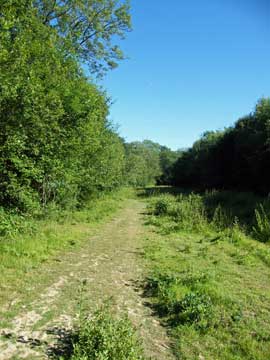
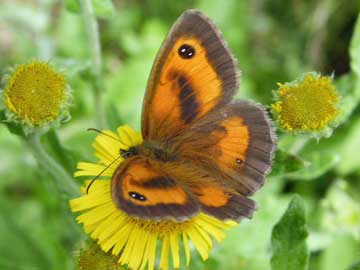

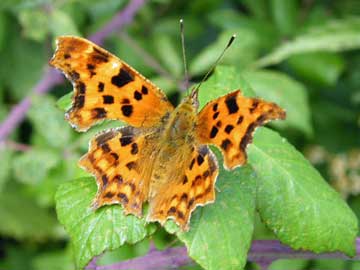
News for Sunday 18 July and today: Grid reference TQ318253. I popped up to the Borde Hill Millennium Woodland between Haywards Heath and Cuckfield on Sunday afternoon and again on Wednesday morning. There had been sightings of Silver Washed Fritillaries and Purple Emperors reported earlier on in July, so I wanted to investigate further. Sadly I did not see any Purple Emperors but there were some Silver Washed Fritillaries gliding around in the rides, one of which I was lucky enough to capture on camera. Other butterflies sighted were numerous Meadow Browns and Gatekeepers, as well as several Ringlets and Large Whites. Also there were single sightings of Common Blue, Large Skipper and Comma (photos above). (Barbara Woods)
News for Sunday 18 July:Buchan Country Park, Crawley: A good year for butterflies at this usually quiet site. Today Silver Washed Fritillary and 4 White Admiral including ab. nigrina. For third year running Purple Emperor have been sighted with 3 records over the weekend, close to the car park. Although numbers were small, a short walk on Sunday produced a tally of 17 species. (Mary-Ann Edwards)
Unfortunately I can't put a name to John Kerby's Abbott's Wood Silver-washed Fritillary 'ab.' without a photograph, as many 'irregular' patterns are quite similar. Even if it can't be labelled for your wildlife diary - it's always nice to see these oddities. I can do better with Damian Pinguey's Small Copper from Warnham (pictured). This is a nice example of ab. obsoleta. (Neil Hulme)
Tuesday 20 July 2010
Heard the devastating news today that the two 300-year-old English elm trees opposite the Co-op in Patcham - on the outskirts of Brighton, have Dutch Elm Disease and will need to be cut down. Last year I recorded a colony of White-letter Hairstreak on these wonderful trees. (Caroline Clarke)
Went into Friston Forest today looking for Broad Leaved Helloborines, which are not quite in flower yet. However was pleased to find 2 White Letter Hairstreaks along the top of Charleston Bottom at TQ5255 0022. Both were nectaring on bramble in an area where the trees were mainly beech. Obviously there was an elm somewhere near. Other species seen were Brown Argus, Meadow Brown, Marbled White, Small Copper, Small and Essex Skipper, Common and Chalkhill Blue. Didn't manage any photos of the hairstreaks but other photos can be viewed on http://seafordbirding.blogspot.com (Matt Eade).
My wife and I were astonished to see a lone Wood White on Ebernoe Common this after-noon Tuesday 20th July. It was flying and settling in the clearing under the over-head cables which leads on from the main path from the church car-park, in company with Silver-washed Fritilleries, Small Whites, Gatekeepers and rather tatty White Admirals. (David Connell)
Am I just lucky or are there more Hummingbird Hawkmoths around this year? I have seen 4 in the past 10 days: 1 on the downs near the Royal E/bo Golf Club, another near the Long Man at Wilmington and 2 in my garden in Old Town - no photos yet, they move so fast! Could be some bonus points up for grabs in the race!!
The roads in Old Town are lined with elms, ref Clare's post, and I scan the canopies too - have to be a bit careful using my bins with upstairs windows tho'!! (Anna Grist)
Bought a new car yesterday evening so we decided to break it in with a tour of the oaks of Sussex looking for Purple Hairstreaks. In each new tetrad we pulled over and scanned the oaks with our binoculars and in every oak tree we found the jittery silver flashes high in the canopy. Purple Hairstreaks were recorded at Brownbread Street, Ponts Green, Penhurst, Darwell Hole, Twelve Oaks, Brightling, Herstmonceux, Windmill Hill, Stunts Green and Ginger's Green. (Michael Blencowe)
A White-letter Hairstreak was nectaring on a white Hebe in my garden (High Salvington) this morning. There is a very small regrowth coming from an old Wych Elm stump in the garden. This is the first WLH here since 1997. The Hebe is between two buddleias and there were also Peacocks, Red Admirals, Gatekeepers, Meadow Browns, 1 Holly Blue and 1 Common Blue. (Peter Atkinson)
Having spent a pleasant hour or so with my daughters in Abbots Wood on Sunday afternoon where we had seen Purple Hairstreaks, Silver-washed Fritillaries, and White Admirals I pottered off for a twilight round of Golf at Wellshurst (between Horam & Hellingly). Mindful of Michael Blencowe's advice on early evening Purple Hairstreak activity and aware that the golf course had significant numbers of Oaks I decided to keep my eyes skyward. Needless to say every Oak I looked at had numbers of Purple Hairstreaks spiralling and tussling and perched and accross the whole site there must be literally thousands given the number of oaks. I dont know if this area is ever surveyed as to my knowledge there aren't any public footpaths although there is a conservation area (which is out of bounds to golfers!). (Chris Ball)
Monday 19 July 2010
Took a stroll through Eastbourne this morning - where the streets are lined with Elms. Staring up into the canopies under perfect sunny / still conditions revealed the familiar dark-grey triangles of White-letter Hairstreaks; still very active. The butterflies were found in two tetrads; TV6096 & TV6098. One butterfly on an elm close to the city centre had chosen a very dodgy territorial perch on a lower branch which was hit by every passing double-decker bus. It returned to its perch regardless of this disturbance. (Clare Jeffers)
Buchan Country Park: Two fairly fresh White Admirals flying round the visitor center at lunchtime today. (Damian Pinguey)
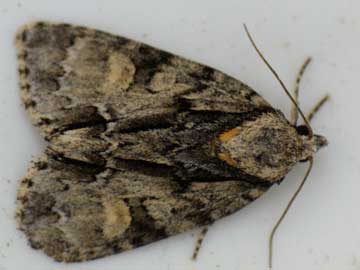
Last night (18th July) a Marsh Dagger (above) was Trapped at Pagham Harbour. (Ivan lang)
News came in to the Sussex Biodiversity Record Centre of a Camberwell Beauty seen in a garden in Maresfield today. The man who reported it watched it for a few minutes as it fluttered around his herbaceous borders, and says that it was different to any butterfly he'd seen before in the garden and looked it up. (Penny Green)
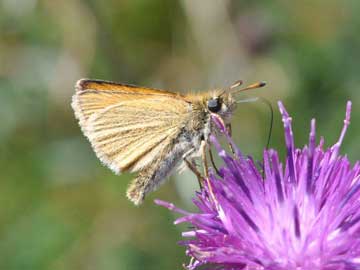
The day started well with a 3 pointer Hummingbird Hawkmoth stopping in the garden and settling briefly. (Mind you this tetrad will not count) This is the first seen in the garden this year and hopefully not the last. As I have neglected my main patch along the Comp and Frog Firle recently as I have been concentrating more on woodlands and the white letters it was good to get good numbers of butterflies back on the Downs. Starting in the so called waste land off the Alfriston Road I found good numbers of Brown Argus along with the common species such as Gatekeepers and Meadow Browns. Common Blue and Marbled White were also very numerous. Along The Comp Ringlets were showing well. I was hoping that Wall Brown 2nd brood might just be emerging but none were seen. Last year the 2nd brood were seen from the 18th, however with the 1st brood being much later this year that may follow as well with the 2nd. However please report any you see. Silver Spotted Skippers were also not seen today but once again it is quite early in the season. In total 21 species were seen today with huge numbers of some. I was trying to get pics of Essex Skippers and I think I got one (above). If its not one Tom will I'm sure let me know!! (Bob Eade).
I went to Park Corner Heath, the weather was warm and sunny but sadly the butterflies didn't want to settle. I saw the following :-
Silver Washed Fritillary (18),
White Admiral (6),
Red Admiral (4),
Peacock (7),
Holly Blue (1),
Large White (3),
Small White (6),
Small Skipper (5),
Speckled Wood (2),
and my favorite butterfly of all, the beautiful Brimstone, of which I managed to see Five. I found out that the word Brimestone in old English means Sulphur. And amazingly in two days I saw 15 species of which 5 I had never seen previously. (Jamie Burston)
Checked the Chalkhill Blue slopes above Butchershole CP this morning and they are now in their 'thousands'. Previously, I had seen a couple of small birds dart out from the bushes to catch a Chalkhill Blue, but today I saw three young skylarks (I think) dashing around trying to catch them, but I could not see if they were successful. Then later I saw what seemed to me to be a male and female chaffinch clearly scoffing them down, pale blue wings flapping in their beaks. I thought chaffinch only eat seeds, etc.??? And do young crows eat butterflies??? Common Blue also appearing in larger numbers. (Susan Suleski)
Seen during my Wider Countryside Butterfly Survey today in 1-km grid square TQ2022 just south of Cowfold, a Purple Hairstreak! This is the first time ever that I have knowingly seen a Purple Hairstreak, but there was no doubt about it because it was resting on oak leaves at eye level and I even had time to focus my binoculars on it. Other species recorded during the survey: Gatekeeper, Meadow Brown, Speckled Wood, Small White, Holly Blue, Small Skipper and Small Copper. Also a lovely green sandpiper on the muddy margins of a small farm pond. (Helen Crabtree)
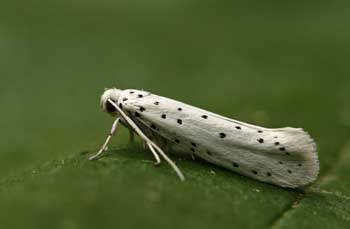
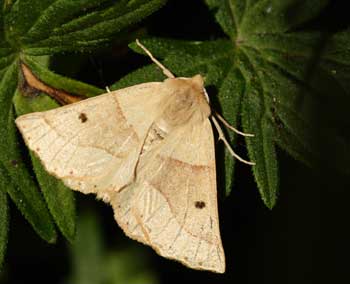
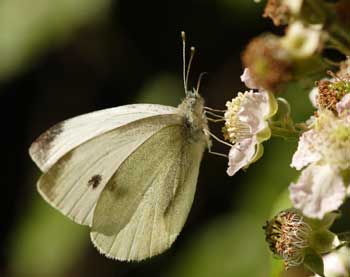
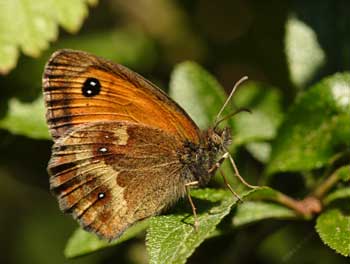
Recent news: I haven't been out and about much recently so these sightings are confined to a) my garden and b) my local tetrad in the Adur Valley. On the 16th July in rather windy weather I saw Small White (4), Gatekeeper (3), Red Admiral (2), Comma (2), Meadow Brown (1) and Speckled Wood (1). Yesterday (18th) in sunnier weather I saw Small Whites, Commas and Gatekeepers in double figures as well as Red Admiral (2) and Peacock (1). I ran my moth trap again on the night of the 17th and opened it up yesterday morning to reveal the following: Drinker (probably the same one that appeared on the 12th), Common Footman, Buff Ermine, Buff Tip, Small Magpie, Brown-Line Bright-eye, Peppered Moth, Dark Arches, Large Yellow Underwing, Dusky Sallow and Scalloped Oak. Micros included Agriphila straminella and Spindle Ermine. My garden is still playing host to a variety of the more common Whites: Small, Large and Green-veined. I've had occasional appearances from Red Admiral and Peacock and a Gatekeeper has been seen here for several days in a row now. (photos above)(Sherie New)
News for Sunday 18 July: Sadly I wasn't able to upload Sunday 18th July as I was to busy, again I went to Hollingbury park and managed to see the following on Sunday :-
Comma (3),
Gatekeeper (13),
Red Admiral (2),
Small White (5),
Meadow Brown (8),
Speckled Wood (2),
Large White (5),
White-Letter Hairstreak (3),
Ringlet (2),
(Jamie Burston)




News for Saturday 17 July: Saturday was a cool, breezy day which proved ideal for a brilliant walk round Castle Hill, Brighton, ably guided by Tom Ottley with Crispin Holloway. Butterflies were everywhere, Small Skippers and, thanks to Tom's expert eye and bins, the occasional Essex Skipper. Common Blue, Chalkhill Blue and Brown Argus appeared plus plenty of Marbled White and a couple of Dark-green Fritillaries which I missed. Peacocks, Gatekeepers, Small Heath and quite a few Small Coppers were around, including a mating pair, plus an iridescent blue Forester Moth and a Great Green Bush-cricket. I have seen a seen several metallic olive coloured beetles recently and photographed this male Oedemera nobilis (female has normal sized hind femora), a False Oil Beetle. There were also hundreds of Six-spot Burnet moths, many of them mating. (photos above) (Colin Knight)
News for Wednesday 14 July: A walk on Kingley Vale (SU825088) in dull weather produced the following sightings:
Large White 2,
Speckled Wood 1,
Ringlet 45,
Meadow Brown 6,
Small White 5,
Gatekeeper 3,
Comma 1,
Brimstone 4,
Marbled White 4,
Essex Skipper 1,
Small Skipper 1,
(Roger Pendell)
Sunday 18 July 2010
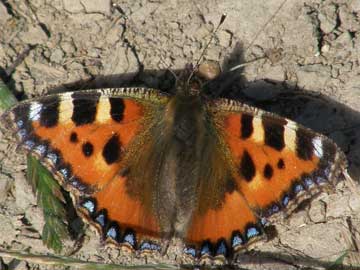
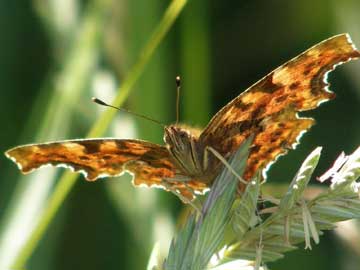
This afternoon the whole family went for a summer stroll from Littlington to Alfriston and back via the river walk. It was not an official butterfly spotting walk, but the camera was taken just in case any happened to be within lense-shot! It was used just a few times today, but managed to capture a few shots. Anyway, we spotted Large White, Small White, Red Admiral, Small Tortoiseshell (above, left), Peacock, Comma (above, right), Speckled Wood, Marbled White, Gatekeeper, Meadow Brown and Small Heath. Alas, none of the classics, but a very enjoyable walk all the same! (Nick Linazasoro)
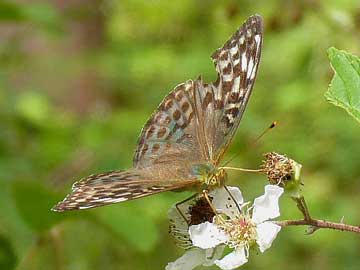
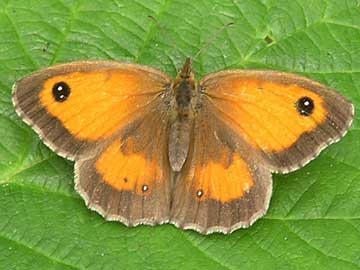
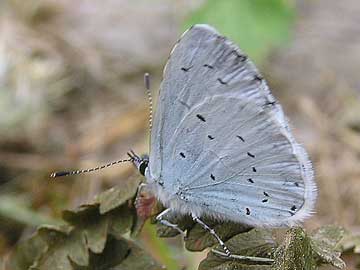
I went for the first time today to take photographs of Butterflies at Spithandle lane woods. Although cloudy I saw the following, Holly Blue, Purple Hairstreak, Meadow Brown, Peacock, Ringlets, Gatekeepers, White Admiral, Comma, Large Skipper, Large White, Small White, Green Veined White, Emperor Dragonfly, Silver washed Fritillaries including a valesina which I pointed out to my assistant who seemed to get very excited and ran off into the forest in pursuit... Georgie Barrott (age 9). Bag carrier and general assistant Richard 9+ (photos above) (Richard Roebuck)
Purple Emperor on dog poo in the car park at RSPB Broadwater Warren (Alan Loweth)
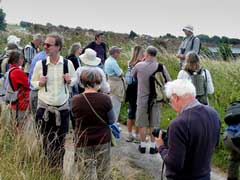
News for Saturday 17 July: Thanks to all those who came to the field meeting at Castle Hill. We were lucky with the weather and the freshly emerged Chalkhill Blues were a real treat to see although the Great Green Bush-cricket and Nottingham Catchfly were close runners-up. Essex Skippers were duly found of course. Thanks to Mavis for help with the plant identification, to Sally for help with the route and to Crispin for his usual dependable support (photo above). (Tom Ottley)
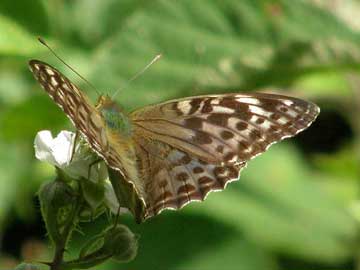
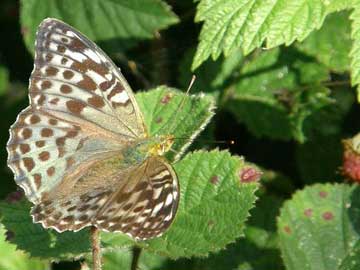
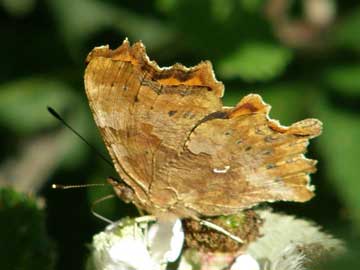
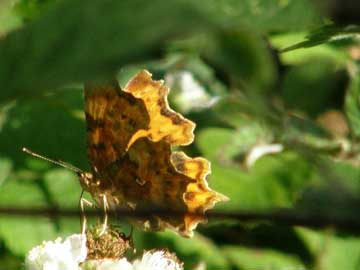
News for Sunday 11 July: Weald and Downland Museum - Singleton, about 4pm - through the entrance building then along the higher path through the wood on the left, past the Gridshell building on the way to the charcoal burning settlement: - at least four Silver-washed Fritillaries and one Comma (above). Despite there being a special event there that day I didn't see anyone else in the woods as I walked through. (Chris Smith)
Saturday 17 July 2010
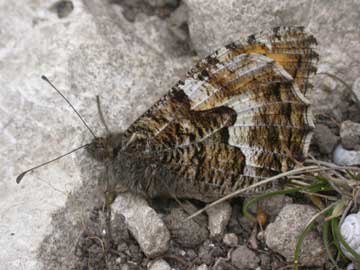
Today's overcast and very windy conditions didn't lend themselves to butterfly watching - but I knew of one hardy butterfly who can handle these conditions. After a climb up breezy Mount Windover I found the first Grayling (above) of the year - the best butterfly on the list. This Grayling had tucked himself into a chalk hollow out of the wind and was laying flat to get the most out of the sun (when it appeared from behind the clouds). When it landed amongst the grass after a short flight it took me 20 mins to find it again - even though it was inches from me - their cryptic camouflage is absolutely incredible. (Michael Blencowe)
Today I walked to Hollingbury park in the morning, later returning again in the afternoon both in poor weather conditions. I managed to see three White-letter hairstreaks, thanks Caroline. Totals are shown below.
Gatekeeper (13)
Meadow Brown (10)
Comma (3)
White-letter Hairstreak (3)
Small White (3)
Red Admiral (2)
Large White (2)
Green veined White (1)
Ringlet (1)
Silver Washed Fritillary (1)
(Jamie Burston)
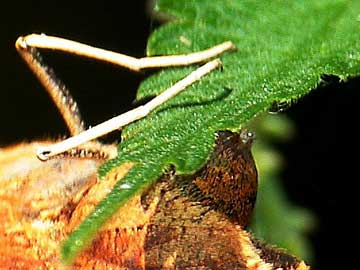
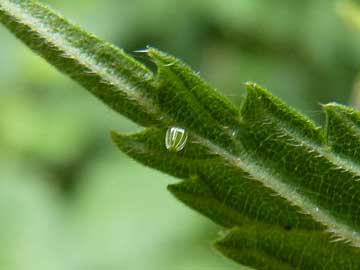
If you are like me and are the wrong side of 40, then the occasional jibe from loved ones regarding forgetting important events etc. comes as no surprise. I will expand. With a digital camera you tend to get a bit happy snappy at anything that moves and as a consequence you end up deleting a lot of pics that clog up your hard drive. So see this "poor" pic of a comma I nearly deleted. On closer inspection its a female with an egg just appearing from her abdomen prior to it being deposited. I took this picture 10.07.10 (it's been cropped to see the detail). Having mentally remembered this I parked the car today walked a mile and a quarter, returned to the same nettle and the same leaf and found the egg which is less than <1mm 1 week later. As the great sage Homer Simpson once said "I can't remember the old stuff as the new stuff pushes all the old stuff out of my brain". Job done. (photos above) (Richard Roebuck)
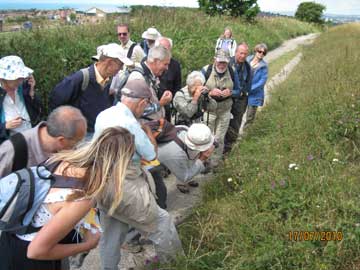
Tom Ottley lead a superb walk at Castle Hill NNR (above) providing useful tips and information on distinguishing, in the field, between Small and Essex Skippers, male and female Marbled whites as well as interesting and useful observations about the butterfly species, crickets, grasshoppers, birds and diverse chalkgrassland flora.
Species seen on the walk: Small Skipper,Essex Skipper, Large Skipper, Large White, Small White, Small Copper, Brown Argus, Common Blue, Chalkhill Blue Red Admiral, Comma, Small Tortoiseshell, Peacock, Dark-green Fritillary Gatekeeper, Small Heath, Marbled White, Meadow Brown, lots of Six-spot Burnet, Silver-Y, Forester moth Great green bush cricket and much more. (Crispin Holloway)
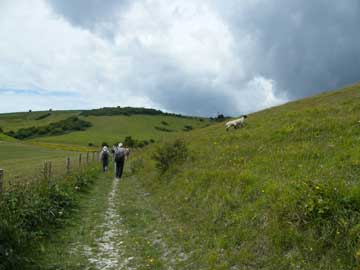
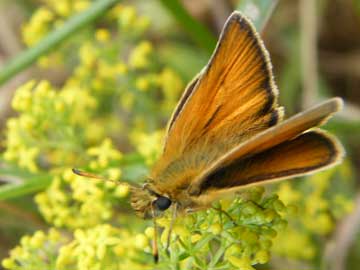
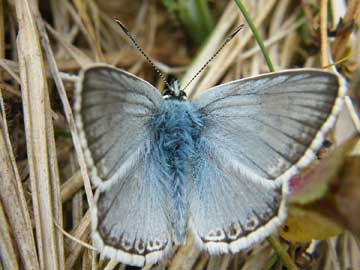
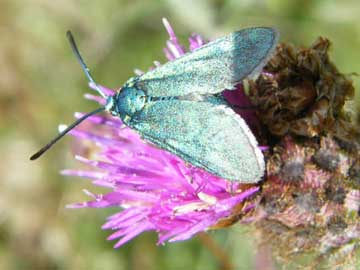
Many thanks to Tom Ottley, who stepped into the breach as Adrian Thomas was unable to make it today, and also to Crispin Holloway for a wonderful walk on the Downs at Castle Hill NNR. It was quite breezy but the rain kept away and we saw a large selection of butterflies and other insects. Everywhere we went there seemed to be Six-spotted Burnet Moths flying amongst the Greater Knapweed, Field Scabious and Rounded-headed Rampion. There were numerous sightings of Marbled Whites, such a beautiful butterfly, Meadow Browns and Gatekeepers, as well as Small Skippers. Just as there were the Gloucester Old Spot Pigs on the walk "Wey Up North" earlier on in the year, livestock made an appearance on this walk in the form of two escapee sheep, who tried to make a bid to return to their meadow with no success on this occasion.
Highlights of the walk included sightings of a Dark Green Fritillary fluttering along the path heading towards the reserve, a Brown Argus that delightfully appeared in a clump of flowers just off the path and the Chalkhill Blue that remained still long enough for us all to not only get a good view of it but also for the photographers amongst us to capture it for the website.
Tom helped us all identify the skippers properly and to distinguish between male and female Marble Whites. Also, we had some flower experts to hand, who helped identify some of the downland flowers. It is such a joy to get out in the beautiful Sussex countryside with such amiable company and to encounter all these wonders of the natural world. It truly lifts the spirits.
Species seen included:
Brown Argus
Chalkhill Blue
Common Blue
Comma
Essex Skipper
Dark Green Fritillary
Gatekeeper
Large White
Marble White
Meadow Brown
Peacock
Red Admiral
Small Copper
Small Heath
Small Skipper
Small White
Moths seen included:
Six spotted Burnet Moth
Cinnabar Moth caterpillars
(Barbara Woods)
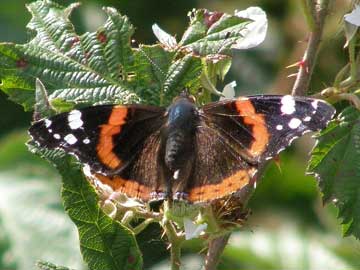
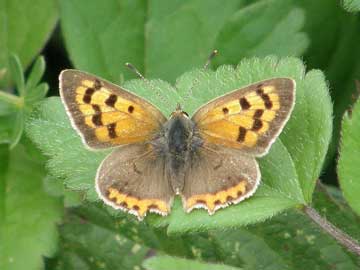
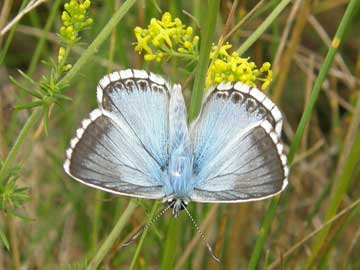
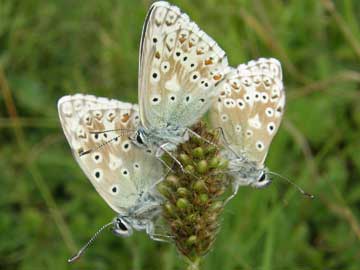

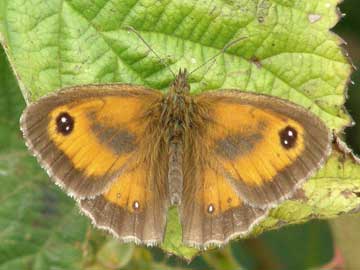
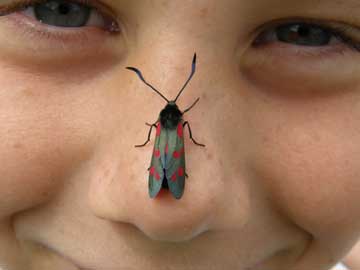
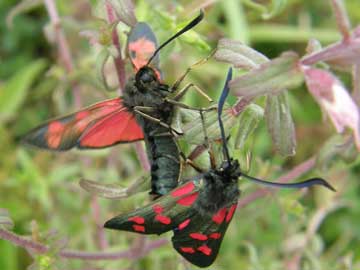
Today my two sons and myself ventured up to The Gallops at Friston Forest in the hope of spotting a few butterflies. Although it was quite windy, we were more than rewarded. In fact, some would say, spoilt! Virtually every step we made once out on The Gallops, we managed to disturb butterflies from the ground.
I managed to get about 100 quality photographs, but this proved to be difficult for me to cut them down so I do apologise to the person that receives my photos on this website. I usually send about 8 but I got carried away, so hopefully a few choice ones will be posted. - apologies accepted, BF
I would have liked to have gone in search of Bob Eade's White Letter Hairstreak's but my boys would have been going ballistic if I was to stand and watch a bush for over 3 hours! I do admire his patience!
Anyway, today (without exaggeration) we must have seen in excess of 1000 Chalkhill Blue (males outnumbering the females greatly). It was quite an experience! Also spooted today were Small Skipper, Large Skipper, Small Copper, Red Admiral, Comma, Marbled White, Gatekeeper, Meadow Brown and Small Heath. There were several Six-Spot Burnet moths and tons of mating red insects. (Nick Linazasoro)
Friday 16 July 2010
Details of the Transect at Bedelands Farm walked today in very windy conditions, species recorded;
Small Skipper, (25)
Large Skipper, (16)
Large White, (4)
Purple Hairstreak, (1)
Small Copper, (5)
Holly Blue, (1)
White Admiral, (1)
Red Admiral, (1)
Comma, (6)
Speckled Wood, (3)
Marbled White, (1)
Gatekeeper, (209)
Meadow Brown, (247)
Ringlet (99)
TOTAL 619, 14 species (David Pyle)
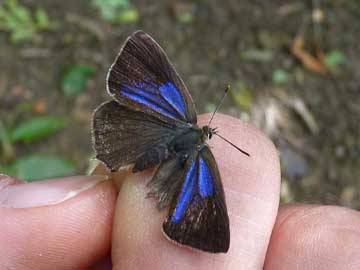
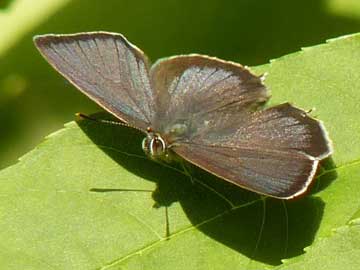
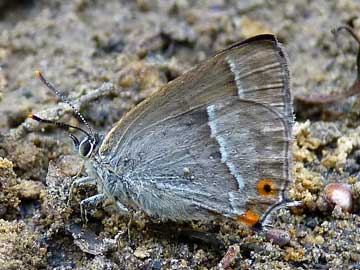
I know the world has gone in to a WLH frenzy and perhaps quite rightly so. I however have continued my pursuit of Purple Hairstreaks yesterday evening with a few more pics. This morning by a stroke of luck I found a an injured female Purple Hairstreak on the ground on a very windy morning at Spithandle Woods. For the very first time I can now see those beautiful iridescent patches on the forewings.(top and side views) Also c.f a typical male. This is probably because she is viewed directly from above something you cant easily do up an oak tree etc. Despite the wind also saw Red Admirals, Small Whites, Green Veined White, Speckled Woods, Meadow Browns, Ringlets, Gatekeepers, Silver Washed Fritillary, Large Skipper, Small Skipper, Commas and one rather battered looking White Admiral ( 13 spp.) (Richard Roebuck)
With reference to Neil Hulme's note and photographs of aberrations on 7 July, we saw a different variation of the Silver Washed Fritillary in Abbott's Wood today. Sorry, no photograph. But the main feature was a dark band approx 8mm wide, extending in an arc mid-way through the fore and hind wings. The colour of the band was similar to the butterfly's normal spots and other markings, and it looked as if they had merged together in this band. I hope this description may be enough for Neil to identify it. (John Kerby)
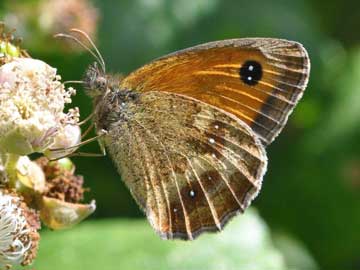
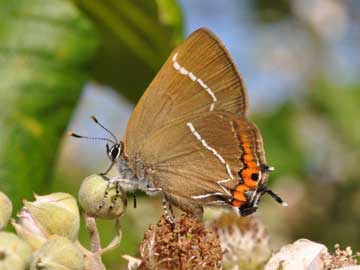
News for Thursday 15 July 2010: Well, maybe I have turned a bit mad having spent just over 3 hours in front of a bush!!! However, this was possibly my last chance of getting some more good views of the White Letter Hairstreaks in good condition at Littlington. On the walk to the site the wind was really strong and I thought there was little chance of the butterflies coming down to nectar on the bramble. Fortunately though the area is quite sheltered and I soon had 5 in view. 1 male and 4 females. The male was past its best and was the only one near, however every now and then a female got nearer, although it was over 3 hours and past 6pm before a female was posing well for the camera. Plenty of other butterflies were also nectaring on the bramble including several Commas, Gatekeepers, Meadow Browns, a Small Copper and an Essex Skipper. Interestingly, all these other species kept putting each other up fighting for flowers etc. but they all ignored the hairstreaks and the hairstreaks ignored them as well. (Bob Eade)
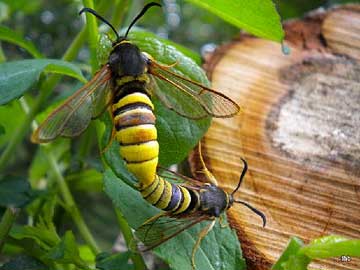
Mating Lunar Hornet Moths (above), Wiston. (Tom Beach)
Tetrad TQ6628 Cottenden near Stonegate TQ270280 1 Large White, 1 Small White, 1 Comma, 1 Gatekeeper, 1 Small Tortoiseshell, 2 Meadow Brown, 1 Ringlet, 1 Red Admiral. TQ6798128905 Limden Wood 1 White Admiral, 1 Silver Washed Fritillary.
Tetrad TQ6828 Cottenden near Stonegate TQ680280 25 Meadow Brown, 3 Gatekeeper. TQ680290 28 Meadow Brown, 5 Ringlet, 1 Red Admiral, 4 Large White, 1 Small White. (Roy Wells)
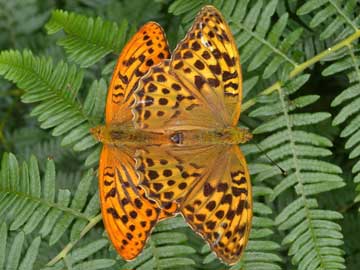
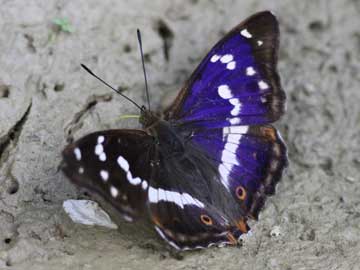
News for Monday 12 July 2010:
Male Purple Emperor and a Pair of Silver Washed Fritillaries, Southwater Woods (above) (Damian Pinguey)Thursday 15 July 2010
Tetrad 4606 Firle Place TQ474071 3 Large White, 2 Small White, 2 Meadow Brown, 1 Peacock. (Roy Wells)
Wednesday 14 July 2010

Despite the cooler weather today I had another look at the Littlington site for the White Letter Hairstreak (above) where I found another area nearby where 2 hairstreaks were seen. At the usual spot I had 2 individuals nectaring. Both were females in very good condition. On the way home I also had 5 fresh Red Admirals at High and Over as well as several Chalk Hill Blues just below High and Over. (Bob Eade)
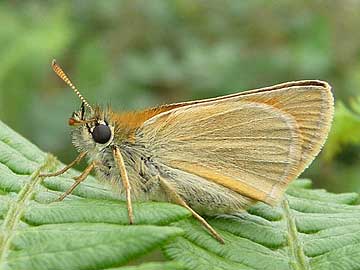
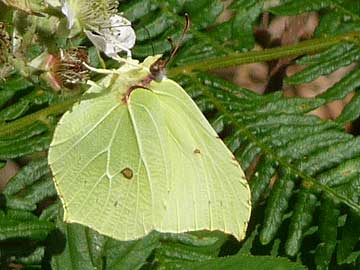
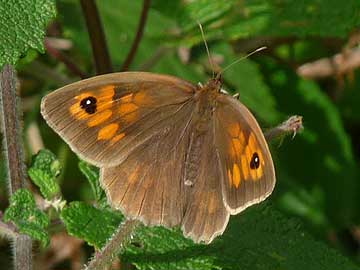
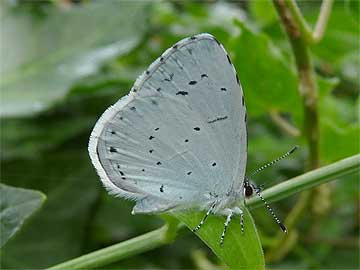
I spent the morning "transecting" in Rowland Wood and Park Corner Heath. There was plenty about, flying when the sun was shining but going to ground as soon as it passed behind a cloud, taking flight again as I walked past, making counting somewhat more tricky. I had two additions to my species list this week: Gatekeeper and Brimstone, the latter seeming to be a particular irritant of the Silver-washed Fritillaries in their vicinity (I get the impression Silver-washed Fritillaries get irritated by most things).
The list in full:
Small Skipper - 2,
Large Skipper - 1,
Brimstone - 3,
Large White - 3,
Small White - 2,
Green-veined White - 1,
White Admiral - 8,
Red Admiral - 1,
Silver-washed Fritillary - 15,
Speckled Wood - 3,
Gatekeeper - 19,
Meadow Brown - 38,
Ringlet - 55,
Amongst the moths I saw were at least 5 Silver Y nectaring on bramble. When I got home I managed to grab a photo of a very fresh Holly Blue investigating an ivy covered fence in my Lindfield garden. (photos above). (Bob Foreman)
Tetrad TQ6406 Pevensey Levels TQ650060 7 Meadow Brown, 2 Gatekeeper, 1 Red Admiral.
Tetrad TQ6404 Pevensey Levels TQ650050 3 Meadow Brown, 3 Peacock. (Roy Wells)
News for Tuesday 13 July 2010: Tetrad TQ6004 Stone Cross TQ607042 1 Red Admiral (Roy Wells)
Tuesday 13 July 2010
It's fantastic to see that a lot of people have been taking the time to 'look up' over the past few weeks. We've been receiving some great records of White-letter Hairstreak and Purple Emperor from new sites across the county. Many people have been pleasantly surprised that their local elms are home to White-letter Hairstreaks. As we've seen from previous reports even the most remote trees (such as the one reported by Andy Stokes in Uckfield) are home to this butterfly. Other reports from Shoreham, Lewes, Brighton and Hove have highlighted that this elusive butterfly can be found even in the most urban environments. Jon Curson reported another colony to me today - found after checking his local trees in Seaford. It's certainly worth taking your binoculars out with you and checking your local elms when summer returns at the weekend - but I'd certainly agree with Paul James and show some caution when carrying binoculars next to schools / swimming pools/ nudist beaches / women's changing rooms at Top Shop etc. (Michael Blencowe)
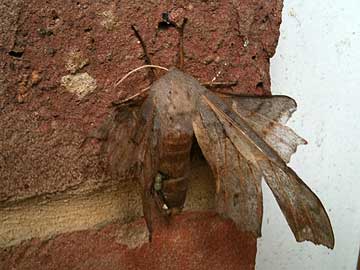
Whilst at work in Crawley today found a very sad specimen of moth (above) which I think is most likely a Poplar Hawkmoth - albeit pale, battered and in possession of only one wing. It appeared to have a wound on its left side but I would say that the green bumps next to this are its eggs. (Caroline Clarke)
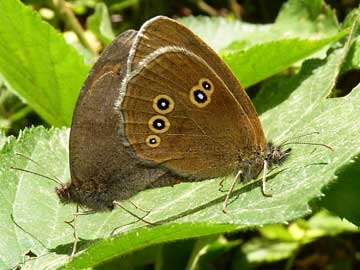
Recent news: I recently reported that I went to find a mating pair of Ringlets, actually I failed because on the computer I realised that what I had actually got a photo of was a male Meadow Brown mating with a a female Ringlet (above). Must have been the hot weather that confused both me and the butterflies. In addition re comment on the Common Footman although first year for me I have had numbers of these and also a few Rosy Footman visiting my moth trap over the past week. (Richard Roebuck)
Monday 12 July 2010
Seen in my conservatory (TQ333085) a freshly emerged White-letter Hairstreak (below, left). She was kept overnight and released onto an Elm growing in my garden the following morning. (Dan Danahar)
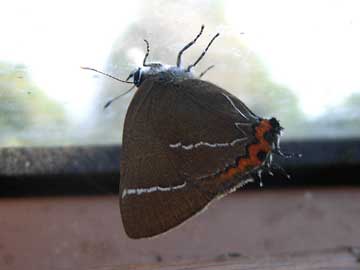
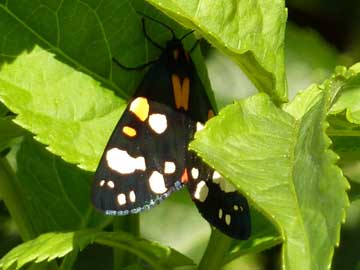
Old Town, Eastbourne: Scarlet Tiger (above, right) seen in my back garden over several days. (Heather Maryson)
I only ran my moth trap until 1am last night but still got a good haul of moths. The ones I've been able to ID so far include: Drinker, White Plume, Riband Wave, Dark Arches, Buff Arches, Agapeta zoegana, Brown-tail, Flame and Small Magpie. There were many more but it is quite a challenge IDg them. Also, in my garden were Small White, Green-veined White, Red Admiral and - a first for this garden - a Marbled White. I'm delighted about the latter and about the Fritillary seen in my garden earlier this month (presumed to be a Silver-Washed Fritillary). It looks like my efforts to make the garden more attractive to passing butterflies are beginning to pay dividends. Neither the Fritillary nor the MW stayed more than a few minutes but they were a real treat to see. I sowed some Horseshoe Vetch seed in the Spring and now have four plants growing (very slowly) so maybe next year I can hope to see some specialist Blues... ok, maybe not but I can dream. Besides, Horseshoe Vetch is a pretty little plant. Luckily, many of our native, butterfly/moth-friendly plants are great additions to the garden, but in saying that I'm probably teaching my grandmother to suck eggs or at the very least preaching to the converted :) (Sherie New)
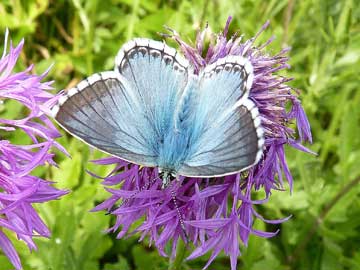
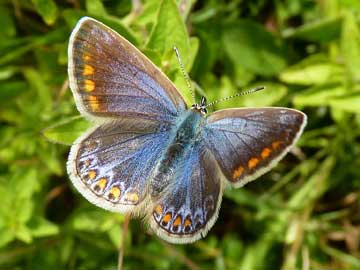
As it was raining first thing Sunday, I went to find a mating pair of roosting Ringlets, which I eventually did. Spent another few hrs at Wiston Woods off Spithandle lane, found another location 100 yds from my last sighting where I saw 2 to 4 Purple Emperors but difficult to accurately count. Between 10.30 and 11.30 a.m. saw 2 individuals on three occasions patrolling but not really dog fighting around a group of trees. Saw one fly over 70 feet over the top of a Sequoia. Also saw some 3 feet over my head. Saw one visit three separate sallow trees one after the other possibly looking for a female. (it seemed to quick to be egg laying). Worth looking around the footpaths and bridleways in this area for more PE.
Late afternoon went to Wolstonbury (Pycombe Street end) it was a bit windy so not ideal, saw 10 Dark Green Fritillaries, Small Heaths, 20 + Marbled Whites, Meadow Browns, lots, Hedge Browns, 2 Common Blues, and only three Chalkhill Blues (perhaps just emerging) (above, left). Pristine Male, and a stunning female Common Blue (above, right).
On Monday as I was in Brighton, 10 minute stop and saw White-letter Hairstreak on an elm opps BHASVIC despite the wind and also another at Inwood Crescent nearby, which is more sheltered. (Richard Roebuck)
Sunday 11 July 2010
White-letter Hairstreak watchers (below) on Caroline's walk at Hollingburuy Park, Brighton. (Crispin Holloway)
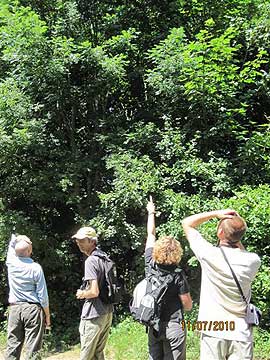
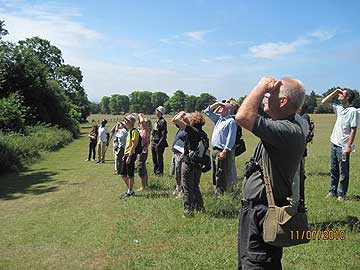
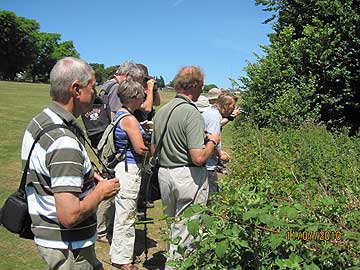
Today Caroline Clarke lead an excellent White Letter Hairstreak Walk at Hollingbury Park, Brighton with useful tips on how and where to look for White Letter Hairstreak and differentiating between the varieties of Elm trees. Once you know what and where to look, it is much easier to see these elusive little triangles jumping around the tree tops and even better when they come down to the thistles.
Other than several White Letter Hairstreak, we also recorded Small Skipper, Large Whites, Holly Blue, Red Admiral, Comma, a possible Silver-washed Fritillary, Marbled White, Speckled Wood, Ringlet and Meadow Brown. (Crispin Holloway)
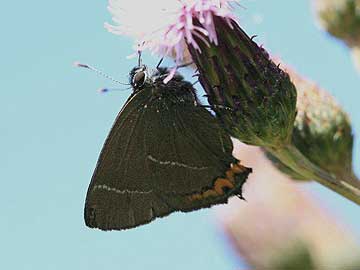
Thanks to Caroline for leading the visit to Hollingbury Park today, and for giving me my first view of White-letter Hairstreak (above). Couldn't have asked for better views. Not sure if Small Copper managed the list of species recorded as one appeared as we were eating lunch after the rest of the group had left! (Roger Pendell)
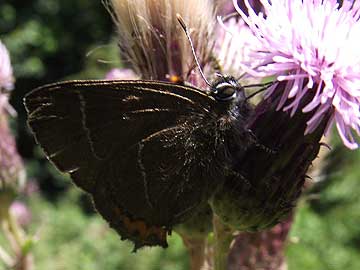
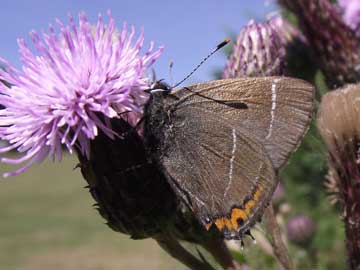
Photos (above) of White-letter Hairstreaks found at Hollingbury park, Brighton. With Caroline Clarke leading the search. (Jamie Burston)
A trip to Broadwater Warren (Nr Tunbridge Wells) this morning produced 21 Large Skipper, 4 Silver Washed Fritilllary, 2 Ringlet, 2 Large White, 1 Small White, 1 Comma (f. hutchisoni - egg laying) (Rob Thomas)
I have never definitely seen a White-letter Hairstreak. There are two small groups of elms about 7 to 10 metres tall alongside the A259 on the left from Pevensey to Bexhill. They both show caterpiller leaf damage and there are small flying insects whizzing about in the canopy though they seem a bit on the small side for the said butterfly. Perhaps if some more experienced member is passing that way they may care to take a look. One of the clumps is at Middle Bridge, one can park at the Pevensey side of the bridge, the other about 100 metres further on next to the lane that leads to the model airplane flying field, one can park there about 30 metres along the lane. If you do stop be very careful, the A259 is a fast road here. (Roy Wells)
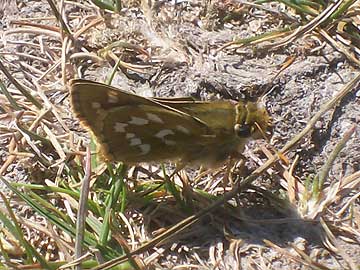
Took a mid-afternoon walk today (Sunday) around Horseshoe Plantation. A plethora of Meadow Browns, Gatekeepers, Marbled Whites, Dark Green Fritillaries, Small Skippers and a few Large Skippers, Red Admirals and Whites. No White-letter Hairstreaks but did see an early Silver-spotted Skipper (above). (Bob Coleman)
A Purple Emperor spent at least 40 minutes in my garden (near Broadbridge Heath) this afternoon from about 2.00pm. Most of the time it just sat on an apple tree and allowed me to approach within inches to take a some photos. It also settled briefly on the lawn.
The day before I saw another Emperor flying in a small area of woodland about half a mile from home at a similar time (David Bridges)
A fantastic day (5 hours in the field) produced 20 butterfly species including: 1 Purple Emperor in "Black Forest" north east of Ansty good numbers of White Admirals and Silver-washed Fritillaries to the east of Ansty. 9 Marbled Whites in rough grassland near Hilders Farm a scattering of Purple Hairstreak sightings 22 Commas 2 Small Tortoiseshells also Holly Blue, Meadow Brown, Small and Large Whites Speckled Wood, Ringlet, Gatekeeper, Small Heath, Small Copper, Peacock, Red Admiral, Large and Small Skippers. (M. J. Silk)
Another evening drive around East Sussex hunting for Purple Hairstreaks - a bit cloudy tonight so they weren't as feisty as normal - the usual riots in the tree tops seem to have been downgraded to minor scuffles in these cooler conditions. Still managed to find them in the oaks at Polegate, Cowbeech, Hailsham, Dittons, Chapman's Town, Carter's Corner, Wartling, Windmill HIll, Puddledock, Chapel Cross, Court Horeham and Punnetts Town. (Michael Blencowe & Clare Jeffers)
News for Saturday 10 July 2010: Many thanks to the tough expeditionary force of 14 that joined me for the lengthy BC walk up the steep face of Heyshott Down, and then along to Graffham and back on Saturday. Given the terrain and energy-sapping heat, this was not a walk for the faint-hearted. However, it attracted a good number of individuals that are actively involved in 'hands-on' aspects of butterfly conservation, including members of both the Murray and Graffham Downland Trusts, and volunteer surveyors. It was also one of the most enjoyable walks I've ever led - no pain, no gain! The views along this beautiful stretch of the Downs were stunning, from start to finish, and the butterflies did not disappoint us. We saw Small Skipper, Large Skipper, Brimstone, Large White, Small White, Green-veined White, Small Copper, Small Tortoiseshell, Red Admiral, Comma, Silver-washed Fritillary, Speckled Wood, Gatekeeper, Marbled White, Meadow Brown, Ringlet and Small Heath. On Heyshott Escarpment we stopped to look at the characteristic feeding damage caused by Duke of Burgundy caterpillars, and spent some time discussing recent achievements in the conservation of this species here. But the stars of the show were of course the high-altitude Purple Emperors of Graffham Down. The first sighting was of a large female, which soon disappeared as she was clearly on a furtive egg-laying run. The male assembly point here is 728' amsl, and we watched a total of 4, constantly doing battle across their territory. Several times we watched a pair of males indulging in a dogfight worthy of 'The Blue Max', tailing each other to heights in excess of 100' above the very crest of the Down, silhouetted against a crystal clear, azure sky. For me this is the very pinnacle of butterfly-watching - pure butterflying ambrosia! (Neil Hulme)
News for Saturday 10 July 2010: We didn't get the news in time to alert you, but hopefully some will have seen the marvellous article in Saturday's Times magazine, written by Simon Barnes. Park Corner Heath, Rowland Wood, Michael and his merry band of volunteers were all given generous column inches in Simon's insightful piece; while Michael's rakish, Mr Darcy good-looks clearly benefited from that hour and a half in the Winnebago. (Neil Hulme)
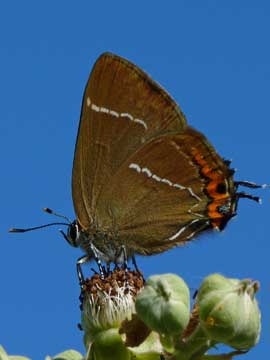
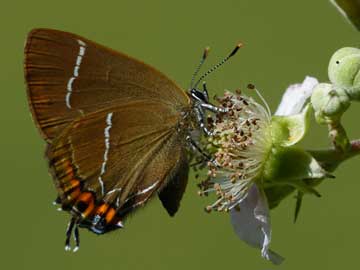
News for Thursday 8 July 2010: During a late afternoon visit to Bob Eade's White-letter Hairstreak (above) site at Litlington, I watched good numbers of butterflies spiralling around the elms, almost everywhere that I chose to stop. The majority of males were beginning to show signs of 'wear and tear', but a couple of very obliging and photogenic females were still in pristine condition. It was also nice to see good numbers of Small Tortoiseshell here (Bob is regularly recording these), and the scarily large horsefly Tabanus sudeticus. White-letters probably occur on the vast majority of elms within the Dutch Elm Disease Control Area, so it's a case of 'eyes up' to help both Caroline Clarke's Species Champion efforts, and The Atlas project. (Neil Hulme)
Saturday 10 July 2010
"You'd know Michael Blencowe for a nature-reserve warden at 500 yards in fading light without binoculars. And not just because of the beard and the deeply distressed outdoor clothing. It's in the jizz, as birders say; in movement and general demeanour. It's in Blencowe's air of total absorption in his surroundings. Anywhere out of doors is his natural habitat."
Simon Barnes, The Times, Saturday 10 July 2010.
Unexpectedly had Fri. off work so decided to explore the Royal Eastbourne Golf Course and adjacent downland which is in my tetrad, as best I could, avoiding golfers! Quite a lot is accessible by public footpaths and it proved excellent - Large White 2, Small White 2, Small Copper 3, Comma 2, Speckled Wood 2, Small Tortoiseshell 1, Gatekeeper 4, numerous Marbled Whites, Meadow Browns and Large Skippers, Dark Green Fritillaries 3 and a Hummingbird Hawkmoth. I also ventured onto the course to investigate a couple of elm trees and was delighted to spot 2 dark b/flies spiralling above the canopy - White-letter Hairstreaks (confidently id'ed after my session with Susan in Diplocks Wd to get my eye in!) Unfortunately at this point a well-intentioned golfer asked me to get back on the footpath as I was in danger of being hit by a ball!! Undeterred, I have been in contact with the Environmental Committee at the club and look forward to a "field trip" by golf buggy round the course - have also been given a detailed flora/fauna map of the course which is very impressive. Was pleased to meet a fellow Sx BC'er surveying the same tetrad who had also seen WLHs in the area. Popped into Hampden Park en route home from S/burys this evening having taken Michael's advice and indeed found Purple Hairstreaks fighting in oak canopies - a lovely sight! (Anna Grist)
On the slopes above Butchershole Bottom an explosion of Chalkhill Blues with hundreds flying low. Several females also seen including a mating pair. Also seen were my 1st second brood Small Blues with once again a mating pair. Lots of Forester Moths also flying and another Hummingbird Hawkmoth seen. (Bob Eade)
Last night had my first Heart Moth for my Hailsham garden - unfortunately escaped before I could get any pics due to laxness on my part! (Chris Ball)
Further to my post on 26th June about an unusual sighting of a White-letter Hairstreak in my urban garden in the middle of Uckfield - the same insect stayed around the Virginia Creeper for the next few days and I was able to get close enough to see the red portion of the rear wings was missing. However it was joined over the next few days by another, perfect specimen. They both stayed for a few days then disappeared, but I was unable to get anything other than an extremely poor shot. Today, however, I saw 2 individuals in the elm situated at the busy crossroads in the middle of Uckfield (TQ473 207). I have never seen them there before and this elm is very isolated - in fact, I don't know where the next nearest tree is!! Sorry for the long post but perhaps Caroline will find it of interest - what on earth were they doing on my creeper for that amount of time?? (Andy Stokes)
At least 11 White-letter Hairstreaks at Home Bottom, north of Denton. 2 males and a female were observed nectaring on bramble at around 3 pm. Also several Gatekeepers, 30+ Small Skippers, 5 Essex Skippers, 100+ Marbled Whites, 12 Brown Argus. The Skipper colonies were completely mixed even down to a male Essex sharing the same thistle flower as a female Small but they completely ignored each other - they clearly have no identification problems. (Tom Ottley)
During a trip to Highdown Hill this morning the following were observed: - Plenty of Meadow Browns and Gatekeepers, Red Admiral, Small and Large Skippers, Marbled Whites, Comma, Speckled Woods, Common Blue, Holly Blue, Large and Small Whites and plenty of Five and Six Spot Burnetts. (Pete Ashley)
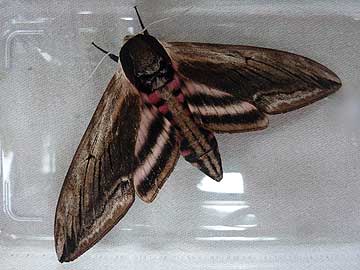
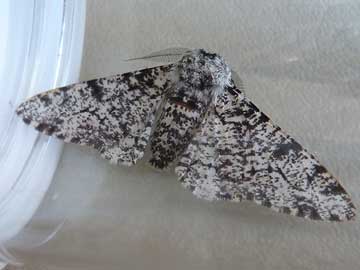
Trapped again in our small garden in Hampden Park, numbers not high but again some different species. Barred Yellow, Willow Beauty, Magpie, Swallow-Tailed Moth, Common Footman, Peppered Moth, Large Elephant Hawk Moth and our first Privet Hawk Moth, also Light Brown Apple Moth and 1 Ermine Micro Moth. (photos above) (Ron & Brenda Elphick)
I would just like to report a sighting of a Purple Emperor near Forestside in West Sussex. I was walking with my wife and two children on a track that leads into a wood, and just before the wood I spotted him on some horse dung. Unfortunately we did not have a camera. My father also spotted a White Admiral and Silver-washed Fritillary yesterday. (Fred Duncannon)
I have long had a hunch that White-letter Hairstreaks should occur in Kingston Lane, Shoreham but have never got round to looking untiltoday despite it being only 5 minutes walk from where we live.Opposite the southern entrance to Shoreham Academy (formerly KingsManor School) there is a long line of elms on the east side ofKingston Lane (TQ237056). This morning we saw two at the northern endof these elms at about 10:00 and then another about half way along.They spent the whole time flitting round the canopy though I did seeone settled through binoculars. If you do go and look for them,weekends might be best as there are two schools close by so strangerswith binoculars might be viewed with suspicion. Also a Small Tortoiseshell and then a Clouded Yellow in Phoenix Way, Southwick. (Paul & Bridget James)

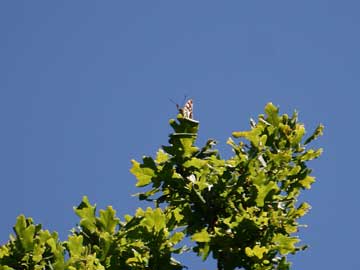
The day started with emptying the moth trap which was bulging at the seams 40+ spp including a Female stag beetle, my first ever Small Elephant Hawk and Eyed Hawk, Thorns, Swallow-tailed Moths, Riband Wave (both forms), Large Emerald, Small Emerald, Buff Arches, Brown-tail, Blood-vein, Elephant Hawks, I have identified 24 spp but along way to go with the others if at all. Also an enormous Crane fly with very unusual patterned wings.
Short walk on downs link, Purple Hairstreak, Hedge Browns, Meadow Browns, Commas, Small Skipper, Marbled White, Large White. Then off to Warren wood nr Washington (its a recognised spot for WLH,) I believe I saw two White-letter Hairstreaks, small dark butterfly flying along just above tree line (first ever seen), also Purple Hairstreak, Meadow Brown, Red Admiral, Marbled White, Hedge Brown. As temperatures soared headed for sanctuary of Spithandle Woods. At the refurbished bridle path lots of White Admirals and Silver-washed Fritillaries, including one mating pair and the unusual green form. More Commas, Meadow Browns, Hedge Browns, Purple Hairstreaks, Small and Large Skippers although fewer and most worn. Then to another section of woods just getting out of the Car when I saw a Purple Emperor at the top of a hazel hedge which then majestically glided off up and over an oak tree. Waited around for a while but didn't see it again. My mind was troubled, was it or wasn't it. Off in to the woods, found the biggest pile of horse manure I have ever seen with a butterfly on top. deep breadth, its a Comma. Next found a Purple Hairstreak egg laying low down on an oak twig, great. I spent about 4 hrs in the woods, lots of Silver-washed Fritillaries, White Admirals, Red Admirals, Hedge and Meadow Browns, Ringlets, Large and Small Whites, Commas, male Brimstone, Marbled Whites, loads of Beautiful demoiselles. But best of all I found another Purple Emperor on top of his (home tree) (above) It's been a long long search to find this. I spent an hour flat on my back watching him intermittently soaring around his patch chasing the odd Purple Hairstreak it was fascinating. He was at least 35 feet up so taking pics was extremely difficult with my little camera, but that wasn't really the point it was just great to watch my first proper found Purple Emperor in Spithandle Woods. What a Fantastic day. (Richard Roebuck)
Returned to a new potential White-letter Hairstreak site close to Ditchling Beacon at TQ 323 112. Having seen 1 White-letter here on the previous afternoon, I decided to come back earlier in the day. Despite warm sunshine & very little breeze I couldn't confirm any sightings. However, this is a good spot for butterflies in general. Species seen were Marbled White, Meadow Brown, Small Heath, Small Skipper, Gatekeeper, Common Blue, Comma, Large White, Small White. Moved on to Hollingbury Park where I recorded 6 White-letter Hairstreak. (Caroline Clarke)
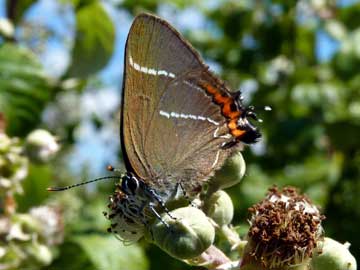
Spent a cracking morning/early afternoon at Litlington watching Bob Eade's White-letter Hairstreaks (above) which were nectaring on Bramble flowers. Initially they were a bit awkward however as the day progressed they seemed to visit in increasing numbers and become quite photogenic! Also 5+ Comma, many Gatekeeper & Meadow Brown, Small Tortoiseshell, Red Admiral, Small Skipper. (Chris Ball)
Slopes above Butcher's Hole CP - there are now hundreds (not yet thousands) of Chalkhill Blues on the slopes between the CP and the gallops a week after first emerging - all (?) males thus far. Also, lots of Meadow Browns and Marbled Whites, Gatekeepers (3), Dark Green Fritillaries (3), Small Coppers (3). (Susan Suleski)
Recreation grounds and playing fields are often an easy place to spot Purple Hairstreaks. That's because they tend to be fringed with oak trees and the open aspect means plenty of evening sunshine. This evening they were to be seen at Five Ashes Playing Field, Framfield Recreation Ground, Cross in Hand Recreation Ground and Waldron Recreation Ground. They were almost abundant at the last site, being seen on 11 trees with at least 12 on just one of those. As has been said before, it's easiest to see them between 7 and 8 pm on a sunny day. (Tom Ottley)
Reported via Brian Easlea - Humming-bird Hawkmoth in Buddhist Centre Gardens, Lansdowne Road, Hove on 8 July and up to 3 White-letter Hairstreaks same site. Round the corner in St Anne's Well Gardens up to 6 White-letter Hairstreaks all week. (Peter Whitcomb)
Friday 9 July 2010
Toady's count at Beacon Hill LNR, Rottingdean was by far the best of the year so far, and included first sightings of Clouded Yellow and Gatekeeper. Totals were: Small/Essex Skipper 13, Clouded Yellow 1, Large White 1, Small White 3, Common Blue 4, Small Tortoiseshell 1, Dark Green Fritillary 3, Marbled White 81, Gatekeeper 14, Meadow Brown 69, Small Heath 4. (Peter Whitcomb)
Abbots Woods: Spent over an hour wandering in the woods and saw lots of Meadow Browns (seemingly all male), over 20 Silver Washed Fritillaries, several Ringlets, Large Whites, Gatekeepers (3), Red Admiral (1), Small Copper (1). Met a couple who had seen several White Admirals today and had picked up an injured Purple Hairstreak a week ago. I encouraged them to report their findings here in future. Then I spent the rest of my walk getting a cricked neck scanning the oak canopy in vain. Have now read Michael's advice to look after 6.00 p.m. and will check Diplock's Wood later this evening. (Susan Suleski)
Details of the Transect walked today at Bedelands Farm, very hot with temperatures in the high 80's, still must not grumble.
Species recorded;
Small Skipper (59)
Large Skipper (4)
Large White (12)
Small White (3)
Purple Hairstreak (1)
Small Copper (5)
White Admiral (3)
Red Admiral (2)
Comma (4)
Gatekeeper (10)
Meadow Brown (643)
Ringlet (147)
Total butterflies counted, 893, 12 species. (David Pyle)
We went to look for Bob Eade's Littlington White Letter Hairstreaks this afternoon. We were delighted to find them in 2 locations about 80 yards apart. First quite a number flying around the tops of a group of elms by a bend in the river (TQ 520 019). Then one nectaring on bramble (at great length) and 2 flying above at 520 018. There are so many elms here I can well believe there are numerous colonies. (John Kerby)
Tetrad TQ7620 Compasses Lane, Cripp's Corner TQ775207 20+ Meadow Brown, 20+ Essex Skipper.
Tetrad TQ8422 Clayhill, Beckley. TQ840230 4 Large White, 39 Meadow Brown, 2 Red Admiral, 1 Comma, 2 Gatekeeper, 1 Small Tortoiseshell.
Milldown Wood 3 Speckled Wood, 3 Brimstone, 1 White Admiral.
TQ850230 23 Meadow Brown, 1 Large White.
TQ850220 Bixley Wood 15 Meadow Brown, 3 Speckled Wood, 2 White Admiral, 1 Red Admiral, 2 Comma. (Roy Wells)
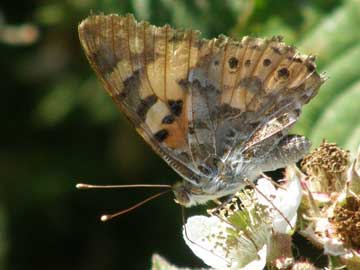
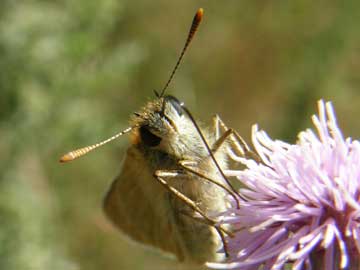
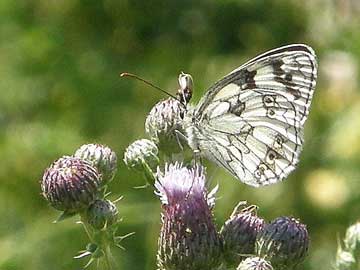

Today I had a very quick lunch-time wreckie up to Cissbury Ring. I was fortunate to spot the following butterflies: Small Skipper, Large Skipper, Small White, Painted Lady, Comma, Dark Green Fritillary, Marbled White, Meadow Brown, Small Heath and a Cinnabar Caterpillar (photos above). (Nick Linazasoro)
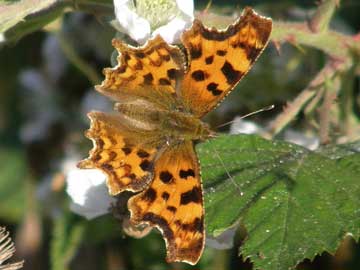
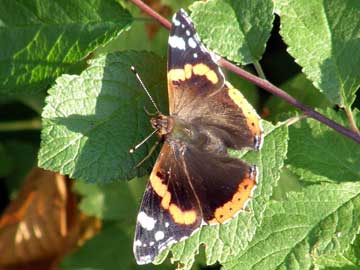
This evening I had a brisk walk to the rear of Chalvington Field, Seaford and then onto Frog Firle and Seaford Golf Course in order to work off some pounds. Yes, you guessed it, I still managed to take a few butterfly shots! This evenings list included: Large Skipper, Red Admiral, Painted Lady, Small Tortoiseshell and Comma (photos above). (Nick Linazasoro)
On Bedelands nature reserve in Burgess Hill I saw 2 White Admirals, 2 Silver Washed Fritillaires, 1 Marble White. (Sandra Solly)
Diplocks wood: of course, Michael is right! Followed his advice and found Purple Hairstreaks in the oak canopy in the evening. Not quite as easy as he seemed to think, as seeing the tops of oaks in a wood in the evening sunshine can be hard. I reckon I have now seen 18 butterfly species in these small woods - and hope for more! I phoned my daughter to tell her to look for Purple Hairstreaks in Abbots Wood, which she visits most evenings, and she said she thought she saw a Purple Emperor there yesterday. A flash of purple, seen several times, caught her attention: large dark butterfly flying slowly along the ride edge. She is pretty certain it was not a White Admiral which she saw several of. I don't think anyone has reported Purple Emperors in Abbots Wood this year - what about previous years?? (Susan Suleski)
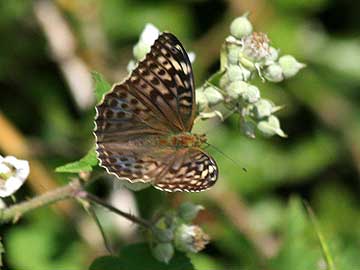
News for Tuesday 6 July: A walk through Ebernoe Common on 6th July produced the following sightings:
Silver washed Fritillary 24 (including 1 valezina - above)
Meadow Brown 115
White Admiral 10
Purple Hairstreak 1
Small White 3
Marbled White 3
Ringlet 40
Small/Essex Skipper 33 (positive identification Small 4 Essex 3)
Large Skipper 2
Comma 1
Speckled Wood 4
Small Heath 3
Large White 1
(Roger Pendell)
Recent news: On Sunday 4th July me, my brother Tom, Dad and Mum went out with Neil Hulme to look for Purple Emperors at Botany Bay. There were a few clouds and quite a strong breeze which Neil said was not that good for the Emperors because they get blown over easily. We spent more than 3 hours walking round and our first view was flying across a path but I didn't really get a good view. Later we saw another one up in a tree but I didn't see that very clearly either. We thought we weren't going to get a good view but Neil seemed to know the best place to look and at the last minute we got very close to one on a track in a sheltered spot. It was tempted to sit on the ground by some smelly fish bait. Neil said we had to be creep very carefully and not rush until the butterfly was settled down or it would fly away. Luckily it stayed still and we all got really close views.
I really like butterflies and the Purple Emperor is really beautiful. We also saw lots of White Admirals and Silver-washed Fritillaries. One White Admiral was unusual because it'didn't have a white stripe.
Thank you Neil for a brilliant day. (Ellie Corrigan)
Thursday 8 July 2010
Took a trip into Brighton to do some shopping. Whilst waiting at the traffic lights spotted 2 White-letter Hairstreak on a street elm tree opposite the sixth form college, BHASVIC, on Dyke Road (TQ303 054). On foot I found 4 more White-letters on wonderful ancient elm trees in the graveyard of St Nicholas Church also on Dyke Road (TQ307 045). Unfortunately didn't stay long here as is also favourite haunt of chaps who were a bit 'worse for wear' and who were overly interested in what I was doing hanging about gazing at the heavens. Driving home, I spotted a further 2 White-letters on another street elm on Dyke Road (TQ304 054). When I got home recorded 1 White-letter checking out the nectar on a tall Philadelphus in my own garden. Moved on to Hollingbury Park in the afternoon and counted 6 more White-letters. A total of 15 White-letter Hairstreak in one day with the first seen at about 10:15 and the last at 3:30pm. Other butterflies include at least 12 Comma in Hollingbury Park, together with 2 Small Skipper, Gatekeeper (sometimes doing quite good White-letter impressions), Meadow Brown and whites. (Caroline Clarke)
Tetrad TQ5608 Milton Hyde TQ560080: 20 Meadow Brown, 6 Silver Washed Fritillary, 3 White Admiral, 1 Large White, 11 Marbled White, 1 Common Blue.
Tetrad TQ5606 Gate Wood TQ570070: 27 Meadow Brown, 1 Silver Washed Fritillary. (Roy Wells)
One Heart Moth trapped in my garden near Broadbridge Heath last night. This is five days later than the single Heart Moth I trapped in the garden in 2009. (David Bridge)
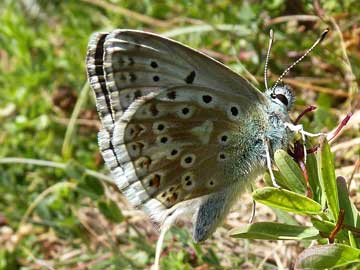
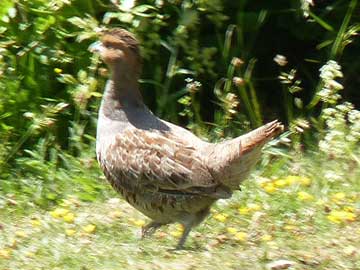
Spent an hr at Mill hill in searing temperatures just to see what was around, Peacock 1, male Brimstone 1, Meadow Browns lots, Hedge Browns 20 +, Common Blue 1, Red Admiral 2, Small Heath 10, Large White 2, Six-spot Burnets, my first and only Chalkhill Blue of the year on the bottom slope and also near the car park a Pair of English Grey Partridges who must have had chicks nearby as they were clucking loudly and one was doing a great impression of being wounded, flapping around all over the place (hence the blurred pic). Great to see these and a suprise to see in such a public place(photos above).
P.S. the flowers look fab. (Richard Roebuck)
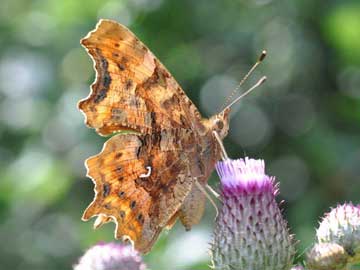
Decided to survey the elms trees that run from Littlington to Alfriston today to see if more White Letter Hairstreaks are there. Pleased to find 4 more colonies of them with several fighting males seen at the tops of the trees. I ran out of time so only covered half the distance I was hoping to. I'm sure there are plenty more colonies between the 2 villages with elm running the whole distance. Also some very fresh Commas seen (above). (Bob Eade)
Trapping in the last week or so has been fairly good, with 270 moths of 54 species in the garden trap this morning, the highest count this year. New moths for the year included our first Lozotaeniodes formosanus, V-Pug, Barred Yellow, Beautiful Hook-tip, Shark, Coronet, Nutmeg and Buff Arches. Hawk-moths seem to be having a good year this year, with up to 10 Large Elephant Hawks visiting the trap some nights and Privet and Small Elephant also putting in a good show. One family that is significantly down in numbers though this year at Mill Hill is the Footman, with a Common Footman being the only species of this family caught in the last two weeks. Is anyone else seeing a reduction in their numbers this year?
We ran a moth trap at the weekend up on the Downs in an area of grazed chalk Downland, with quite substantial scrub. We had never trapped in this type of habitat at this time of year before so we were not sure what to expect. In the end we encountered 38 species including one of our absolute favourites, a female Ghost Moth. We also caught 2 Reddish Light Arches, 2 Drinker, 2 Small Elephant Hawks, 2 Large Elephant Hawk, 1 Swallow-tailed Moth, 2 Square Spot and a Broom Moth. The landowner was very excited to see some of the catch and was surprised at the number of species there were on his farm.
Finally, the conditions look great for trapping in the next few days so make sure you get your trap out. Its hopefully going to be warm, humid and cloudy. Good luck! (Dave and Pen Green)
After tea tonight (a nice bit of fish and spinach) we decided to head out for some butterfly action. With the time heading towards 8pm we drove off The Downs and went hunting for some oak. Each time we saw an oak bathed in the summer sunset we pulled the car over and reached for the binoculars - and flying around every oak were Purple Hairstreak - loads of them! We recorded them in 10 2km tetrad squares from Ripe to Foxhunt Green. After spending pretty much all the day doing absolutely nothing at all these butterflies go completely crazy after 6pm. Look up in the oak canopies and you'll see these silvery butterflies tearing around the tree - sometimes in gangs of 10, 20 or more - as males fight and compete for females. Some trees may have up to 100 hairstreaks whirling and spiralling around them. It's an incredible sight and is probably happening in an oak near you each evening. It's worth taking a stroll in your neighbourhood after tea and looking up at the oaks. We need plenty more records for this species so please post any sightings on this website or email them to sussexgrayling@aol.com (Michael Blencowe)
Wednesday 7 July 2010
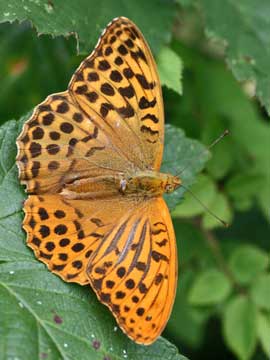
Today at Southwater Woods butterflies were out in good numbers despite the overcast conditions. I encountered Colin Knight's bilateral gynandromorphic Silver Washed Fritillary (above) (now nicknamed "Freddy" for short) as well as a couple of other aberrations. There were good numbers of SWF on the wing as well as White Admiral, Red Admiral, Comma, Peacock, Marbled White, Meadow Brown, Ringlet, Gatekeeper, Speckled Wood, Large and Small Skippers, Purple Emperor and Purple Hairstreak. (Susie Milbank)
Tetrad TQ6406 Pevensey Levels TQ650060 50+ Meadow Brown, 1 Small Tortoiseshell, 1 Common Blue.
TQ650070 50+ Meadow Brown, 2 Small Tortoiseshell, 1 Red Admiral. (Roy Wells)

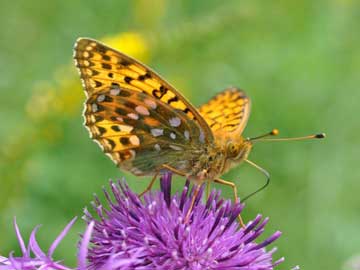
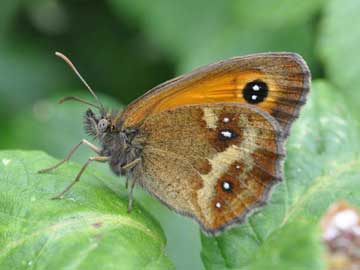
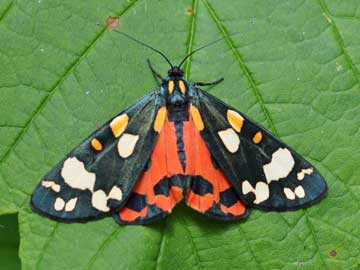
From Butchers Hole in Friston Forest found 5 Chalkhill Blues, my first for the year. On the edge of the Forest a Hummingbird Hawk Moth was nectaring on bramble along with a couple of White Admirals. In the Forest itself 8 Scarlet Tiger Moths as well as remnants of another 3 that had probably been predated by spiders. Many excellent specimens of Dark Green Fritillaries still showing. I then couldn't resist another look at the White Letter Hairstreaks at Littlington. The weather had by now clouded up but still 3 seen as well as a very smart Gatekeeper (photos above). (Bob Eade)
Recent News: In celebration of the fabulous year we are experiencing for both the Purple Emperor, and unusual, dark-coloured aberrant butterflies, I've put together a collection of images taken at Southwater Woods and Botany Bay recently. The aberrants include 'black' White Admirals (ab. obliterae with grey smudges where the white bands should be; and ab. nigrina - lacking even these markings), Silver-washed Fritillaries (ab. confluens), Ringlets (ab. arete - without 'eyes') and Small Tortoiseshell (ab. nigrita). Others have seen dark, aberrant Commas, such as ab. suffusa, so keep your eyes peeled and have a really good look at everything at the moment! Thanks to all those that attended my Southwater walk last weekend - and submitted reports to the website. For those members that missed out on the fun, the trip on Saturday should be equally rewarding. Last Sunday I ran a VIP trip for Ellie Corrigan and her brother Tom (Mum and Dad were invited along too!) to see the Purple Emperor in all his glory. You can read whether we were successful or not in my diary, hosted by Pete Eeles' wonderful UK Butterflies website at http://www.ukbutterflies.co.uk/phpBB/viewtopic.php?f=29&t=4065&start=100 (Neil Hulme)
Purple Emperor, Botany Bay, 4 July and enthusiasts (right):.
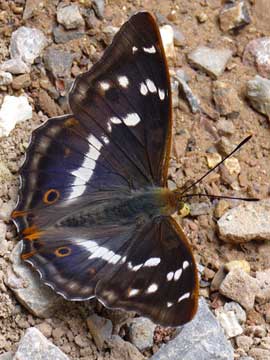
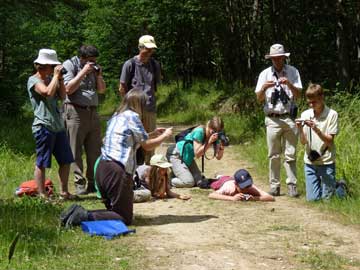
White Admiral ab. nigrina:
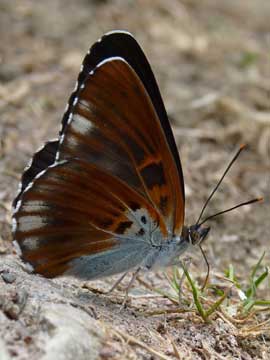
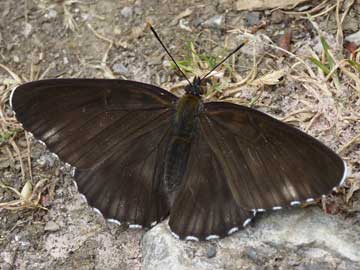
Silver-washed Fritillary ab. confluens (left) and White Admiral ab. obliterae (right):
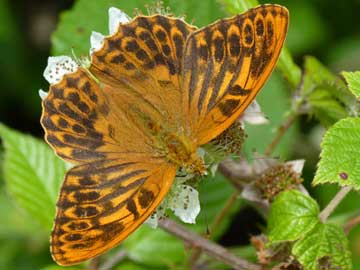
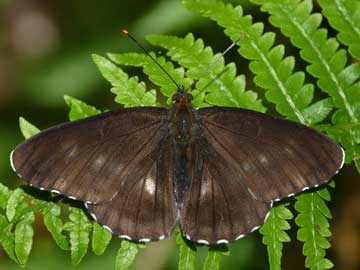
Small Tortoiseshell ab. nigrita (left) and Ringlet ab. arete (right):
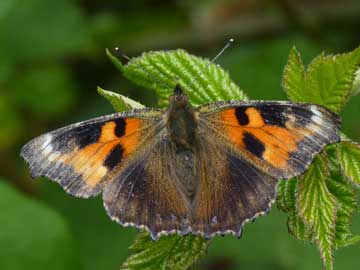
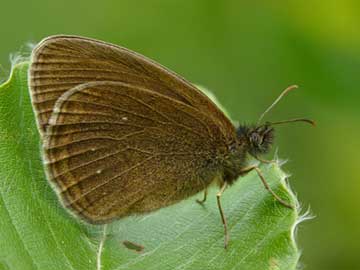
Purple Emperors:
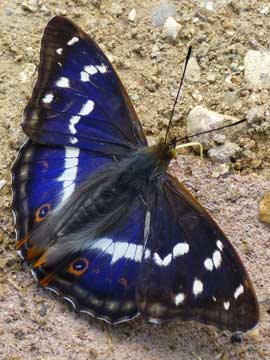
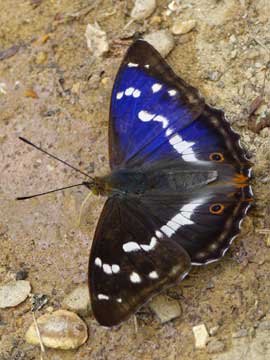
Tuesday 6 July 2010
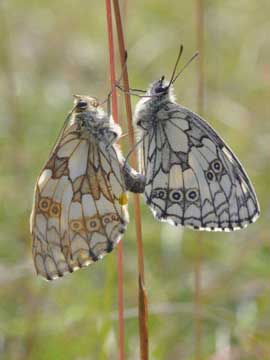
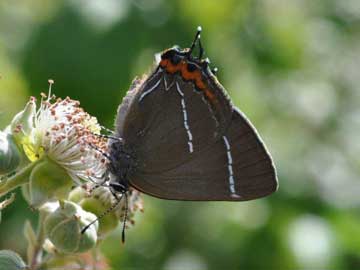
Yet another look at Plantation Wood for the White Letter Hairstreaks was a blank, however, on the way to the wood from Birling Gap I found a mating pair of Marbled Whites amongst the large numbers of these butterflies flying. I then went to Littlington to once again look for the Hairstreaks and at last I found some. Not only that but I found some feeding on bramble, 4 years almost to the day that I last saw them in close up. Some were also in fabulous condition. I must have seen at least 20 in the area although it was a very long wait for 1 to come close enough to photograph. At last I feel some reward for the hours spent looking for one of my favourite butterflies over the last couple of weeks. Also seen was my first Gatekeeper of the year as well as a Southern Hawker dragonfly. A great morning to think about tonight when I am at work!! (photos above) (Bob Eade)
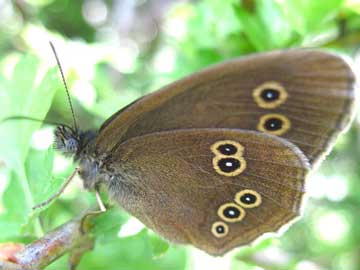
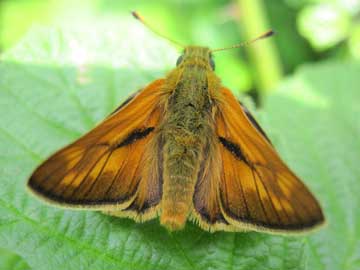
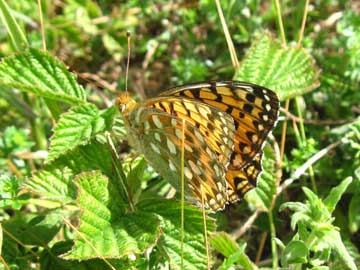
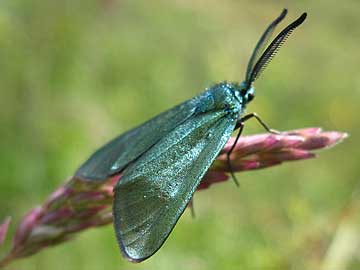
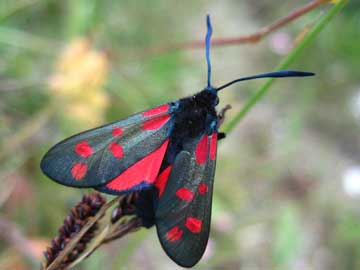
The range of butterfly species and number of individuals is increasing after the June gap. The sward is very dry on the south facing slopes and there are loads of grasshoppers at Malling Down.
Transect at Malling Down, Lewes, E Sussex:
Today's total & (previous weeks total in brackets).
4 (0) Small Skipper,
2 (2) Large Skipper,
3 (0) Small Copper,
0 (2) Common Blue,
2 (0) Red Admiral,
1 (2) Small Tortoiseshell,
1 (0) Peacock,
1 (0) Dark Green Fritillary,
1 (0) Comma,
38 (3) Marbled White,
83 (34) Meadow Brown,
16 (17) Small Heath,
12 (1) Ringlet,
4 (1) Six-spot Burnet,
0 (1) Cinnabar,
1 (0) Forester Moth
The Dark Green Fritillary is the first I have recorded on transect at Malling since an individual was recorded in 2000. I am not sure if the Forester Moth is the more common Adscita statices or the less common Cistus Forester, Adscita geryon or even Scarce Forester, Jordanita globulariae. I believe they have all been recorded on the Lewes Downs in the past. Anyone know? (photos above) (Crispin Holloway)
I would like to submit a sighting of a White Admiral butterfly in Hove, East Sussex. I was advised by Katie at butterfly conservation that this would be worth recording. I have never seen one of these butterflies before and I understand that they are in decline. (Nina Elliot-Newman)
Re. Southwater Woods Silver washed Fritillary behaviour: The pair I saw in Spithandle woods recently did something similar. The male was duly carrying the female around however at one point they ended up on some mud in a drying out stream bed. On the ground the male was feverishly flicking his proboscis around the mud either after moisture or salts. He then carried her up onto a hazel branch. One presumes it must be pretty energy sapping and or dehydrating carrying around his spouse in this fashion. Re Nicks Bug it looks like quite an impressive sp. of Longhorn beetle, I saw one yesterday evening as well. (Richard Roebuck)
Monday 5 July 2010
Monday morning - another Elm - another White-letter Hairstreak! On the way to the office this morning I noticed a young elm on the banks of the Ouse at Lewes. When I popped back with binoculars at 10:50 there was a familiar dark butterfly flitting around the elm canopy. If you have an elm near you it really is worth checking between 9-11:30 - we're really keen to get more records from West Sussex. I've had an 80% Elm/WLH hit rate so far. (Michael Blencowe)
My first Chalkhill Blue Butterfly of the year was recorded at 11.06 am on the lower slopes of Mill Hill. (Andy Horton)
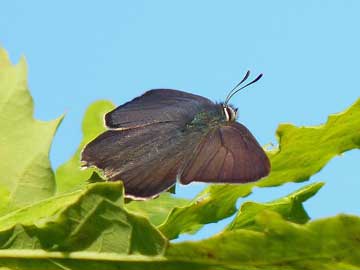
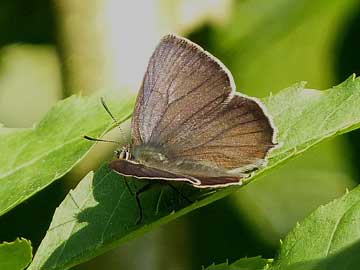
Purple Hairstreaks (photos above) seem to have the same sort of attention span as a whirligig beetle. However after a bit of field craft hanging around (well a lot really) a small ash tree amongst some small oak trees ) I eventually caught a male and a female Purple Hairstrek at at my furthest telephoto range. What I really need is Sherie's lens. (Richard Roebuck)
I haven't been out today but one moth inside tonight, The Herald Scoliopteryx libatrix. Identified thanks to the UK moths site. (TQ362164) (Jonathan Wood)
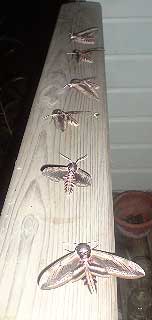
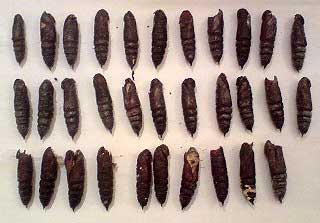
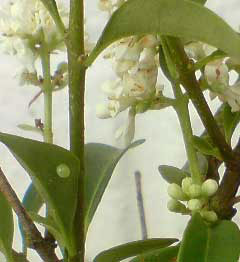
Following our report of a successful paring of two Privet Hawkmoths last year it's been a busy fortnight releasing the outcome of their endeavours. So far 32 have hatched and there are still a few to go. Here is tonight's squadron ready to taxi off (above). They have been kind enough to leave a sufficient deposit of eggs for the next generation. (Josse Davis)
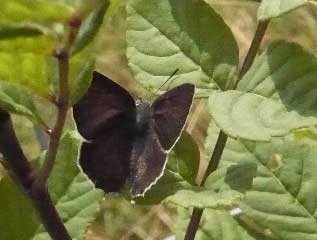
Last week-end while on top of the Trundle, Goodwood with the family watching the Red Arrows fly overhead my eye was distracted by a more exciting flight. Fighting for air space amongst a good number of Marbled White was a male Purple Hairstreak. My son Theo took the picture (above). (Josse Davis)

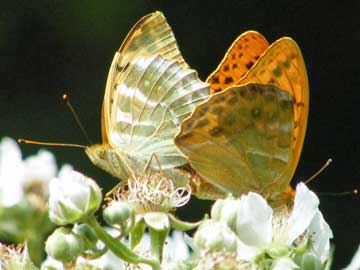
News for Saturday 3 July 2010: Many thanks to Neil for yet another fantastic guided tour of Southwater Woods and the chance to see the amazing Purple Emperors and a profusion of beautiful White Admirals and Silver Washed Fritillaries. Neil showed us the prime areas to spot the Purple Emperors and related tales of how aggressive those found in Sussex are compared with Purple Emperors found in other parts of the country. Apparently they have been known to attack birds, as well as other butterflies, that intrude on their territory and this was witnessed at first hand, when one flew at one of the group. Also, Neil told us about the mating dance of Silver Washed Fritillaries and we were lucky enough to spot two mating but exhibiting behaviour not quoted in the reference books or ever observed by Neil. The male was nectaring on bramble blossom, flitting from one nectar source to the next, with the female in tow during copulation.
Aberrant forms of Comma and White Admiral were seen too. Apparently this occurs when the day and night temperatures vary greatly while the butterfly pupae is forming, usually around early June. A truly wonderful day (photos above).
Species seen included:, Comma - both second brood and aberrant forms, Large Skipper, Large White, Meadow Brown, Purple Emperor, Purple Hairstreak, Ringlet, Silver Washed Fritillary, Small Skipper, Speckled Wood, White Admiral - including aberrant all black forms (Barbara Woods)
Sunday 4 July 2010
Took a long hike in breezy winds and inappropriate footwear around Brightling today - taking in tetrads TQ 6620, 6622, 6820 & 6822. Recorded White Admiral, Small Skipper, Purple Hairstreak, Painted Lady, Silver-washed Fritillary, Red Admiral, Small Tortoiseshell, Comma, Ringlet, Meadow Brown, Large Skipper, Large White, Speckled Wood (Michael Blencowe & Clare Jeffers)
Out on a reckie for my field trip next Sunday 11th July at Hollingbury Park (TQ316 076) in Brighton I saw 2 White-letter Hairstreak up high in the elm canopy. Was very breezy so not ideal weather for spotting them. Am hoping that in a week's time the creeping thistle will be in full flower, the females will be out (they are always so much more accommodating - posing nicely on the thistle instead of fighting each other up high like the boys do!!) and with a bit of luck on the weather we might just get up close. Was very pleased to bump into last year's young person's photo competition winner, Jamie, who was also out White-letter hunting. Other butterflies seen at Hollingbury Park were 1 Comma, 2 Small Skipper, 5 Large White, 1 Red Admiral & numerous Meadow Brown. Moved on to a line of immature elm along the nearby Surrenden Road (TQ310 076) and recorded 4 more White-letter Hairstreak. (Caroline Clarke)
One Purple Emperor high in canopy, 10 White Admiral, 16 Silver-washed Fritillary wood near Plaistow (Margaret Hibbard)
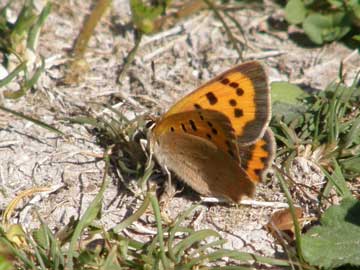
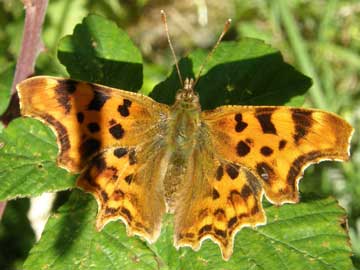
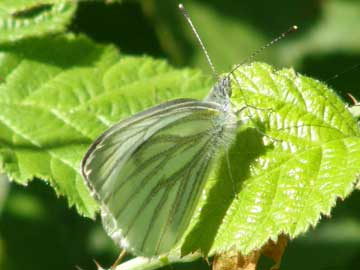
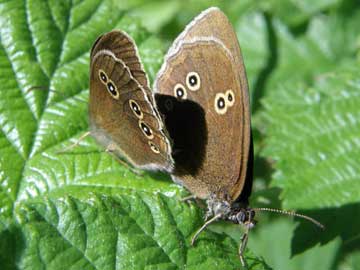
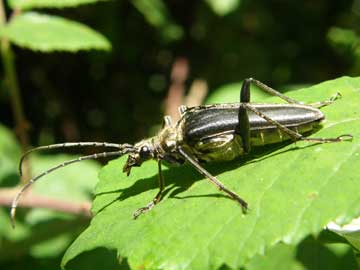
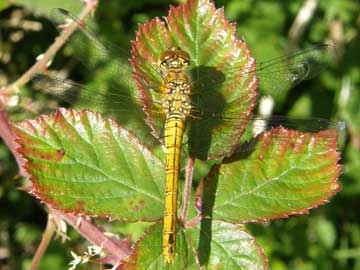
Today I ventured to Malling Down to top up the weekend butterfly spotting. I managed to get quite a few decent shots not only of butterflies but also of dragonflies, damselflies and a mystery beetle or bug. However, the butterflies spotted this afternoon were: several Large Skipper, a couple of Large White, lots of Small White, three Green-Veined White, one Small Copper, one Red Admiral, lots of printine (and agressive to other butterflues) Comma, one Speckled Wood, one Marbled White, tons of Meadow Browns, several Ringlets (including a mating pair flying around) and Small Heath. So 12 species in total. Not bad for an afternoon stroll, except I have gained an increasingly itchy and expanding red bite on my leg! So no shorts next time! (photos above) (Nick Linazasoro)
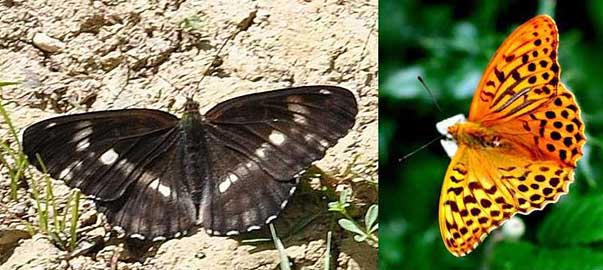
The Purple Emperors stayed aloft at Southwater this morning. Three were twirling around the top of the master tree but none came to the ground for any of the twenty plus enthusiasts who were searching. A pair of Silver-washed Fritillaries coupled on a branch high up. I came across two unusual forms - a White Admiral where the white markings are blurred and a Silver-washed Fritillary which is a bilateral gynandromorph (one side male and the other female, thanks to Neil Hulme for indentifying this rare form for me) (photos above). (Colin Knight)
Marbled Whites were flying early morning on both Saturday and Sunday at Blatchington reservoir (Seaford). Also Small Tortoiseshell. (Chris Brewer)
Like a falling leaf a Swallow-tailed Moth, Ourapteryx sambucaria, dropped out of the tree canopy on to the meadow on the verges of the Coastal-Downs Link Cyclepath midway between Old Shoreham and the Cement Works at Upper Beeding. Nine species of butterfly were seen on the Adur Levels during the morning including frequent Ringlet Butterflies, three Wall Browns, three Comma Butterflies and one Small Skipper. My trip was curtailed quickly because of excessive bicycle traffic. (Andy Horton)
Recent news: In response to your request for Scarlet Tiger records, I caught two in a moth trap on the night of 24-25 June in my very small garden in Brighton (on Belton Road, off Ditchling Road). A dead individual was found nearby on 2 July last year. (Jeremy Patterson)
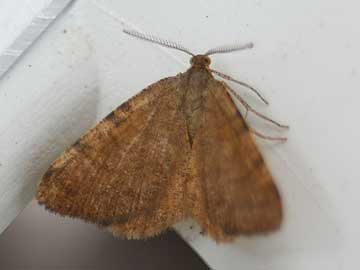
Rannoch Looper (above) we descovered in our moth trap on Friday night (18 June) in Catsfield, East Sussex TQ719135 (Rob Brownnutt)
Saturday 3 July 2010
Drove 'round the local area this morning on a White-letter Hairstreak hunt. In Jevington churchyard (home to the rare Weeping Serpentine Wych Elm) we found one White-letter Hairstreak within seconds of getting out of the car (at 08:52am). At Selmeston churchyard we watched two battling male White-letter Hairstreak spiralling above the Wych Elm. We popped in to Seaford on the way home and found a Wych Elm in the corner of Micklesfield Park - complete with a White-letter Hairstreak. That's three more tetrads marked with a WLH for the atlas. The coastline between Shoreham & Eastbourne has the world's largest poulation of mature English Elm trees - check out a tree near you. The butterfly can be seen best between 9:30-11 on warm mornings - look for dark butterflies flying around the canopy or spiralling up in the air as they engage in battle. Join Caroline Clarke in Brighton at her event on 11th July to 'get your eye in' with this species (Michael Blencowe & Clare Jeffers)
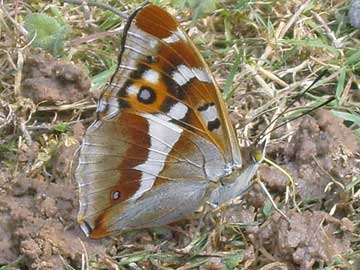
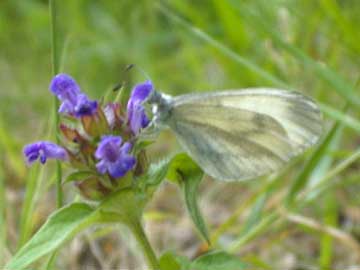
What a wonderful day at Botany Bay! My three year old son Elliot and I left the wife to her baking and set off in search of the Purple Emperors which were now showing according to your sightings page. Silver Washed Fritillaries, White Admirals, Meadow Browns, greeted us straight away from the car park. Speckled Woods, Large Skipper, Small Skipper added to the list up till the bridge. Just the other side on silver birch we saw two Purple Hairstreak. We turned right at the first option and along this path we had two Purple Emperors and Common Blue. We had our statutory picnic and set off for home. As if the day could not get better the Red Arrows flew by in an eight plane formation. I knew I was important!!! Just before the bridge, we had what I would guess as a newly emerged Wood White. The perfect end to this perfect morning was arriving home to a kitchen full of freshley made Cakes, Pies, Crumbles....Oh the list goes on & on. Happy sun filled days (photos above). (Steve Morgan)
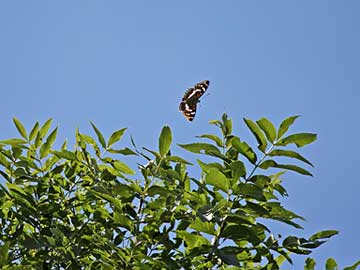
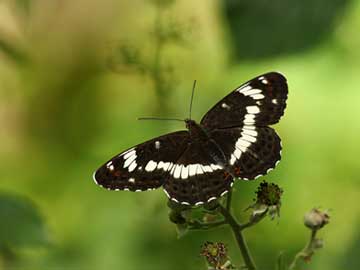
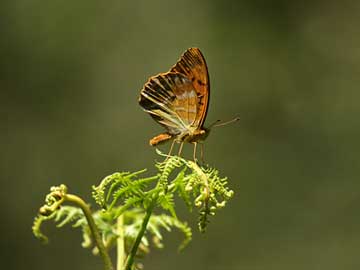
My thanks to Neil for leading this very enjoyable walk. It was great to get reacquainted with Silver-washed Fritillaries, White Admirals and Purple Emperors as these are some of my favourite butterflies. There were plenty of each flying and, although I didn't manage to get up close and personal with the majestic PE, I did learn about where to go and at what times to make that hoped for meeting more likely. Not that we didn't see any on the ground but it did not settle for long. Within a short while it was up and about again. As a result, I think one person got more close and personal than is deemed strictly necessary for PE appreciation as the flying PE bumped straight into him! PEs, apparently, are known for attacking species bigger than they are...
After the end of the walk I stayed behind as it is such a beautiful spot. During this time I did manage to get a shot of a PE flying above the tall master trees at the end of the ride - were they Aspens? - so I've sent it in, along with piccies of the other two main target species. There were also Ringlets, Meadow Browns and Large Skippers in abundance. When I got home I topped this off with two Small Tortoishells in my front garden (photos above). (Sherie New)
The Chalkhill Blues have emerged on their slopes above the Butchers Hole CP! Only counted 7 today, hopefully more everyday. They were on the upper 'forbidden slopes'. The slopes are very parched and I wonder if this will affect numbers this year. Also saw at least 9 Small Skippers (I think) in the grass along the gallops above the slopes and there seemed to be many more. Also, lots of Marbled Whites, Meadow Browns and Small Heaths, and 2 fresh Comma and 2 Small Tortoiseshells. Re my earlier report on White-letter Hairstreaks in Diplock's Wood: I got a very good view of one today and can confirm that my initial report was correct. Thus far I have only seen them in one patch, which is sadly succumbing to disease. (Susan Suleski)
Sightings in our East Dean garden (TV562984)... 2 separate sightings of Humming-bird hawkmoth nectaring on Lavender. Great day because we also had a Red kite riding the thermals overhead for about fifteen minutes. (Carole & David Jode)
Spent a couple of hours this morning at Botany Bay. Highlights were 5 separate sightings of Purple Emperor including 1 on fox scat for 10 minutes and 2 males fighting in mid air. Also 2 Wood White, 1 Purple Hairstreak, 1 Red Admiral and good numbers of Silver Washed Fritillary, White Admiral, Small Skipper, Large Skipper and Ringlet.
In the afternoon went to Iping Common for the first time. Saw at least 80 Silver Studded Blue including a few still in good condition plus 1 Small Tortoiseshell and 1 White Admiral. Non butterfly fare included a magnificent Golden Ringed Dragonfly, 2 Hobbies, 2 Tree Pipit and a family of Stonechats. (Matt Farmer)
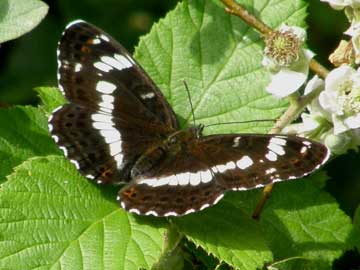
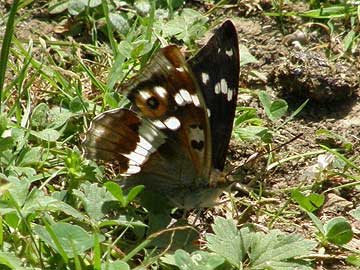
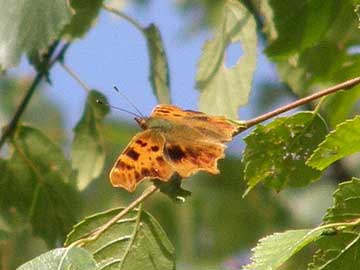

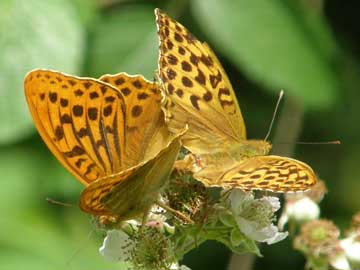
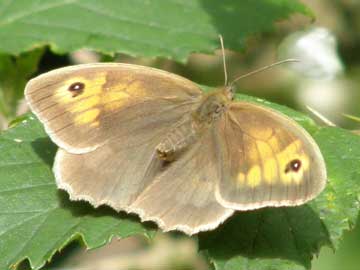
Today myself and my somewhat tired and reluctant eldest son ventured to Southwater Woods to see what Mr Hulme had to offer us! Would it be as exciting as my Botany Bay 7 Purple Emperor Day in 2009?
There was about 25 people on this venture today and a majority of those being far more learnered than myself. So I won't embarrass myself by quoting exact numbers of each butterfly spotted, but we were all lucky to spy at close quarters all of the following: Large Skipper, Large White, White Admiral & aberrant White Admiral, Purple Emperor, Comma & aberrant Comma, Silver-Washed Fritillary, Speckled Wood, Meadow Brown & Ringlet. The family highlight being the Purple Emperor that landed on my sons trainer! (What has the boy been stepping in?)
Once again a successful trip for myself as it was the first time I had ever encountered Silver-Washed Fritillary and an aberrant Comma and aberrant White Admiral. So all in all another enjoyable Neil Hulme venture - well done sir!
PS My son thought that Neil looks like Alan Shearer! (I don't know too much World Cup watching I guess!)(photos above). (Nick Linazasoro)
Seen today 3/7 in and around the parish of Plumpton.
At TQ361128 on the downs:
3 Small Heaths
10 Meadow Browns
1 Common Blue
1 Five Spot Burnet moth
1 unidentified fritillary in pub beer garden TQ363132...
On afternoon walk
3 Meadow Browns TQ359165
2 Meadow Browns TQ356166
2 Speckled Woods TQ356165
4 Meadow Browns TQ354163
1 Marbled White TQ354162
2 Small Skippers TQ355162
1 Comma, 1 Large Skipper TQ355164
1 Small Tortoiseshell TQ361164 (Jonathan Wood)


I made another visit to Cissbury Ring this afternoon to try to get some more shots of Marbled Whites and Dark Green Fritillaries. I was rewarded with a mating pair of Fritillaries, with multiple males trying to get in on the action. The happy couple flew a long way off in the end. Both species were hard to find settled, for long, but were present in hundreds. I came across my first Forester moth, a Six-spot Burnet two Small Coppers, many Meadow Browns, a Small Tortoiseshell, many Small Skippers and a battered Small Blue(photos above). (Colin Knight)
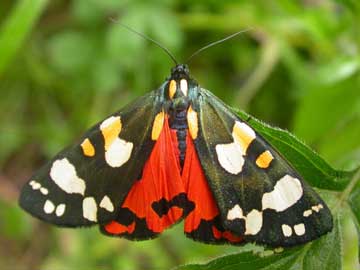
We found three Scarlet Tigers (above)in Friston Forest this afternoon. We've already had reports of this species from Brighton and Eastbourne in 2010 - areas where they seem to have established themselves in recent years. A surprise report was of one caught in a moth trap in Brede in the far east of the county - so it's worth looking out for this moth throughout Sussex and please send any sightings to the website. (Michael Blencowe)
I took a stroll through Tottington Woods, Small Dole yesterday to show some friends the ancient woodland and butterflies. We were delighted to see at least 6 White Admirals as well as Commas, Meadow Browns, Skippers and a Gatekeeper. (Jan Hamblett)
Macro moth species caught in a 40W Heath trap: Heart &, Dart - 2, Dark Arches - 8, Common Footman - 1, Plain Wave - 11, Tawny Marbled Minor - 2, Bright-line Brown-eye - 1, Magpie - 1, Brimstone Moth - 1, Silver Y - 1, Small Emerald - 1, Clouded Silver - 5, Heart & Club - 1, Flame - 1, Buff Ermine - 1, Pale Oak Beauty - 1, Privet Hawkmoth - 1, Large Yellow Underwing - 3, Small Elephant Hawkmoth - 1, Coronet - 1. (James Weston, North Lancing, TQ186058)
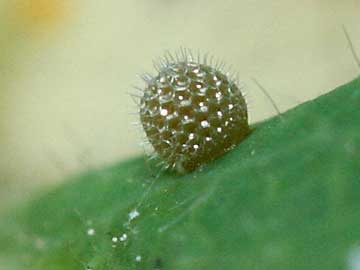
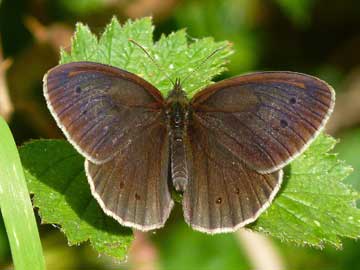
On Saturday spent about four hrs in Spithandle woods with friend Peter. At the Bridleway currently under reconstruction saw 20+ Sliver Washed Fritillaries. (mating pair around 1.00p.m In the morning they were cascading down form the upper canopy like a waterfall. Males were also on the ground collecting minerals from, crushed rubble and ground up chalk Also many White Admirals, Meadow Browns, Comma 2, Large Skippers 15+.
Off to another area deep in the woods to see Ringlets 50+, One ringlet in flight and and later at rest had distinct purple tinge to the forewings I have never seen this before and there is no mention of this in South's book? see pic. Marbled White 1, Small Skippers and Large Skippers, Purple Hairstreaks 3 at head height but flying, Meadow Browns in large numbers. Large White 1. In addition plenty of Silver Washed Fritillaries and White Admirals saw one which was completely black with no markings but had no chance of a Pic. Saw about 8 White Admirals flying in and out of the branches a large Red wood tree between 10 and 15 feet off the ground. Also saw a White Admiral egg laying on Honeysuckle, With a bit of team work found an egg and got a macro pic (above). which vaguely reminds me of The Epcot centre in Orlando. Later on went to Bramlands lane, Woodmancote about 7.15 and saw large numbers of Purple Hairstreaks. Every tall oak had clusters chasing around on the canopy. In a young plantation where the oaks are about 8 feet tall the Purple Hairstreaks were perching on the taller young ash trees, willows and anything with a bit more height where they were easy to see sun bathing and in pursuit. I must have seen in excess of 50 in an hr. Also colony of Marbled Whites 10+ and 10 Small Skippers all roosting together in some long grass and of course Meadow Browns. A fascinating day. (Richard Roebuck)
News for Friday 2 July 2010: Three of the first Small Skippers of 2010 visited the clumps of Tufted Vetch and three strong flying Marbled Whites were seen amongst the long grasses on the towpath from Old Shoreham to Beeding Cement Works. (Andy Horton)
Friday 2 July 2010
At 6.30a.m this morning an early dog walk at Wolstonbury (Pycombe Street end) produced Marble White 15, Common Blue 2, Small Blue 2, Large Skipper 15, Small Skipper 20+, Small Heath 1, Small Tortoiseshell 1, Meadow Brown too many to count and for me the first time saw two Dark Green Fritillaries at his location. No doubt later in the day it will be alive with butterflies. A Peregrine overhead. Scabious and Knapweed in flower amongst orchids and many other species of down and flower stunning. (Richard Roebuck)
Had my first Gatekeeper of the year,this afternoon at Thorney Island.(Barry Collins)
Gatekeeper Butterflies were seen frequently along the Coastal-Downs Link Cyclepath by the Cement Works at Upper Beeding where in the tall meadow verges of Hardheads and Melilot, a few Ringlet Butterflies were seen; both species for the first time this year. A first of the year Southern Hawker (dragonfly) cruised amongst the first flowering Buddleia in the same area. The same area hosted frequent Meadow Browns and one distinctive Cinnabar Moth that fluttered rapidly through the tall herbs making photography impossible.
At Old Shoreham, one Six-spotted Burnet Moth was seen to have recently emerged from its cocoon on a Wild Carrot on the Cyclepath south of the the old Toll Bridge. (Andy Horton)
Transect details walked today in boiling hot temperatures at Bedelands Farm, Burgess Hill. Species seen;
Small Skipper, (28)
Large Skipper, (11)
Large White, (2)
Common Blue,(1)
Red Admiral, (1)
Small Tortoiseshell, (1)
Comma, (2)
Speckled Wood, (3)
Marbled White, (1)
Meadow Brown, (481)
Ringlet, (60)
Total; 591 butterflies, 11 species. (David Pyle)
Went Hairstreak hunting this morning at a group of elms on the edge of Friston Forest and located a White-letter Hairstreak holding territory high in the elms. If you know of any elms in your area it's certainly worth grabbing your binoculars and going out and having a search over the next few weeks. (Michael Blencowe)
2 White-letter Hairstreak spotted fluttering around elm in Saunders Park (TQ 321 060), Brighton whilst planting a nectar garden as part of the Big Butterfly Count event. (Caroline Clarke)
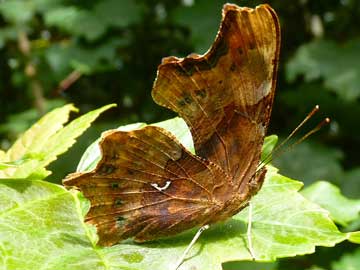
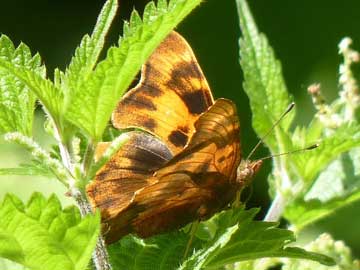
I got a nice pic of a very proud Comma huthcinsoni, note that there is more detail and coloration on the underside of the wing. In addition found my first aberration in a butterfly, like Mr Eade's excellent pic, I believe its ab. suffusa although this one appears slightly different again. Note the wing indentations are distinctly rounded. This form according to South by TG Howarth is produced because the caterpillars feed up very quickly, normal feeding produces the normal form (any other comments welcome) P.S. courtesy of Spithandle woods (photos above). (Richard Roebuck)
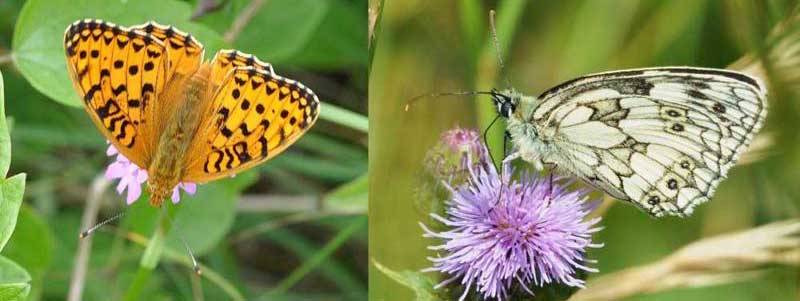
A visit to Cissbury Ring today yielded Marbled Whites all the way round the dykes, but not settloing, plus Meadow Browns, Small Heaths, a few Small Blues, a Ringlet and a Burnet and a Cinnabar Moth. Dark Green Fritillaries were all over the blackberry flowers on the top of the hill, landing and tmbling in twos and threes in the air (photos above). (Colin Knight)
Seen 1/7/10 while meadow surveying near Lindfield @ TQ348280
1 White Admiral (woodland edge)
1 Silver Washed Fritillary (woodland edge)
1 Speckled Wood (woodland edge)
5 Ringlets
10+ Meadow Browns
10 Small Skippers
Seen indoors at home
1 Elephant Hawk Moth @TQ362164.
Seen 2/7/10 while helping at a school stream dipping class in Chailey @TQ390195
10+ Meadow Browns.
4 Small Skippers. (Jonathan Wood)
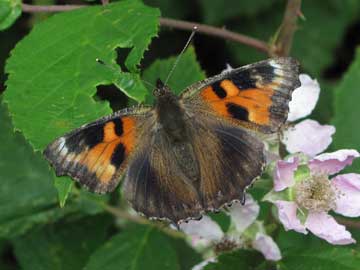
News for Thursday 1 July 2010: First stop was to Oaken Wood/Botany Bay to try to find my first Purple Emperor of the year. This duly appeared by the bridge, having landed on Neil Hulme's boot. Amongst the large numbers of Silver Washed Fritillary and White Admiral there were at least 2 first-brood Wood Whites still flying. Moving on to Southwater Woods in the afternoon, there were even greater numbers of White Admiral, with sometimes 5 in sight at any one time. 2 Purple Emperors were seen flying from the Madgeland master tree. There were a few fresh Commas as well as second-brood Green Veined White and Small White on the wing. Also notable were 4 Red Admiral, some of which looked very fresh. The highlight however was an aberrant Small Tortoiseshell (above) with grey/black hindwings which was on bramble on the track under the power lines, south of the Madgeland master tree. (Vince Massimo)
Thursday 1 July 2010
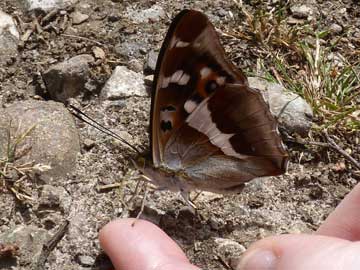
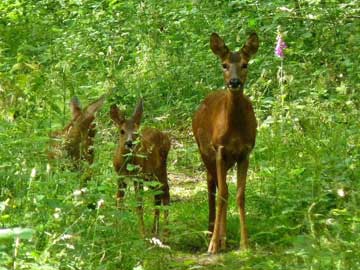
I couldn't resist popping in to Southwater Woods for an hour late this morning. (Purple effect kicking in). Not only did I see another Purple Emperor but I met fellow enthusiast Sandra with whom we had an interesting experience (strictly for research purposes), feeding sweat from my head to said Purple Emperor, who was grateful of this small snack and duly pinned Sandra's finger firmly to the ground with his foot for some 5 minutes or so. In addition I had the great fortune to meet a certain animal I am particularly enamoured with for some reason, a Roe deer with twins - not a common site. As I have said before Butterfliers Beware. (Richard Roebuck)
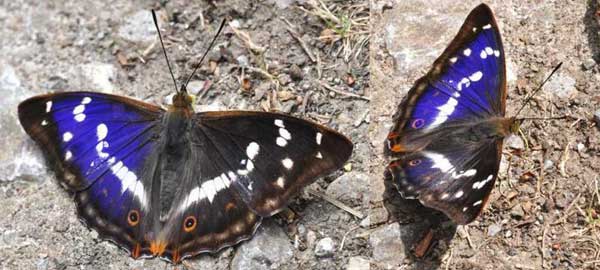
A trip to Southwater Woods again this morning to show Sue and Julie the wonders of our local butterflies turned into a spectacular Purple Emperor encounter. We found five on the ground, three at one spot which we shared with other enthusiasts. We also met a roe deer on the path. (Colin Knight)
Amongst other things it was good to see this dayflying moth at the Butterfly Haven (TQ309072). The Six-belted Clearwing Bembecia ichneumoniformis (below, left). The larvae feeds in the rootstock of bird's-foot trefoil (Lotus) or kidney vetch Anthyllis vulneraria) of which we have masses at the butterfly haven. (Dan Danahar)
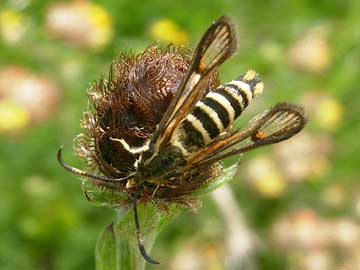
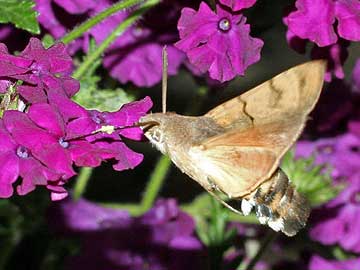
My garden in Burgess Hill is tiny and has very little wildlife. I have filled it with a jungle of buddlea, lavender, jasmine and verbena to tempt as many butterflies, moths, bees etc. as possible and look what turned up this evening - Hummingbird Hawkmoth (above, right). You will have to forgive the dodgy focussing - I've never seen one before and I was so excited my hands were shaking. (Nicki Kent)
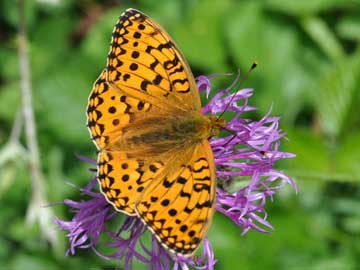
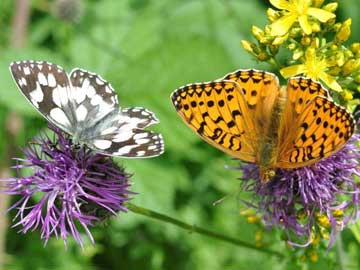
Although tempted to go West again for the 'purple experience' I decided again to look for the White Letter Hairstreaks at Plantation Wood at Belle Tout and Littlington. At Plantation I did find a hairstreak. However, it was a very old Green Hairstreak, for a single brood butterfly this is pretty impressive being seen in 4 different months. There were lots of Marbled White in the field between Birling Gap and the wood. On the way to Littlington I stopped off at Friston Forest where I hoped for nectaring Dark Green Fritillaries. I was not disapointed with several nectaring along the rides. There were a couple of darker individuals, although not as dark as last week's one. I was lucky to get a Marbled White and Dark Green Fritillary nectaring together at one point (above). It was certainly much easier than chasing them all over the Downs!! At Littlington the breeze was a bit high for the Hairstreaks. (Bob Eade)
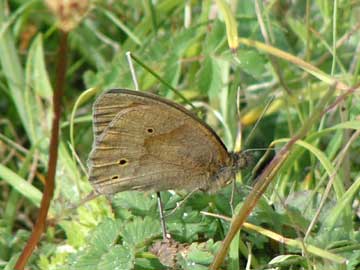
News for Wednesday 30 June 2010: Yesterday afternoon on the western cliffs of Seaford head I photographed butterflies. They were extremely active in the warmth, taking a frustrating time to settle and then only pausing for seconds. Among other species I managed to capture a Meadow Brown as I thought - but on viewing it in the computer I find that it has one feature absent in this species in galleries and reference books: there are prominent dark ocelli showing on the underside of the hind-wing. Browsing the internet I found that Maniola telmessia and M. megala from about the Mediterranean region both show this character, so I'm left wondering whether the photo attached is of one of these species or perhaps an aberrant form of our meadow brown, Maniola jurtina? Can anyone help please? (Keith West)
Reply from Neil Hulme: Variations in the spotting pattern, and size of spots, particularly on the underside of the hindwings, is well documented in the Meadow Brown. However, this is quite an unusual example. There is a detailed discussion of this topic on pp. 262 & 264 of 'The Butterflies of Britain & Ireland' (Thomas & Lewington, 2nd Edition, 2010). It takes an eagle-eye to spot what amounts to quite a subtle departure from the norm, but it's a UK born and bred jurtina rather than an 'incomer'.

 We try to show something from everybody who sends images in, but we can
only display a limited selection so that people with slow computers can
still open the page easily.
We try to show something from everybody who sends images in, but we can
only display a limited selection so that people with slow computers can
still open the page easily.